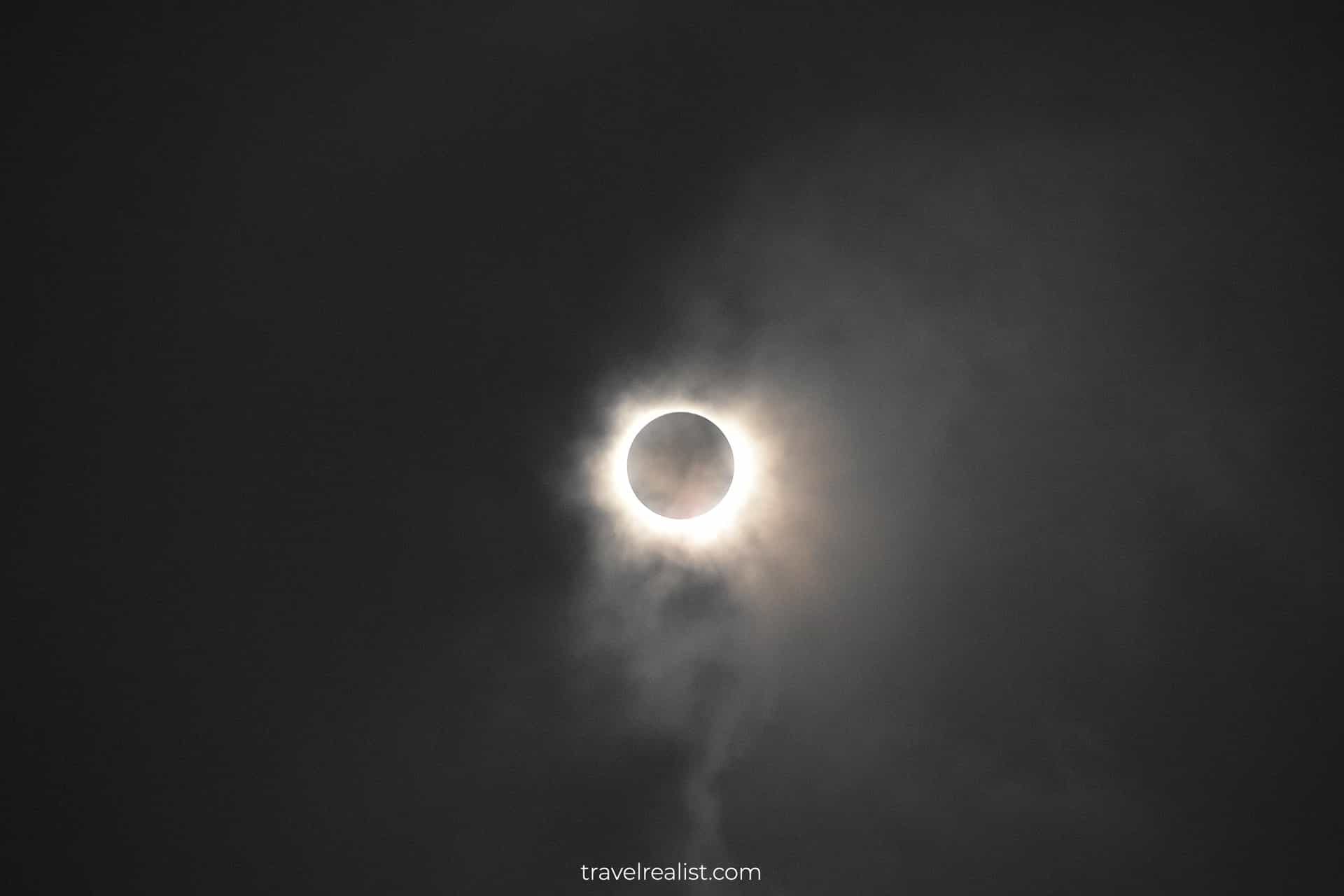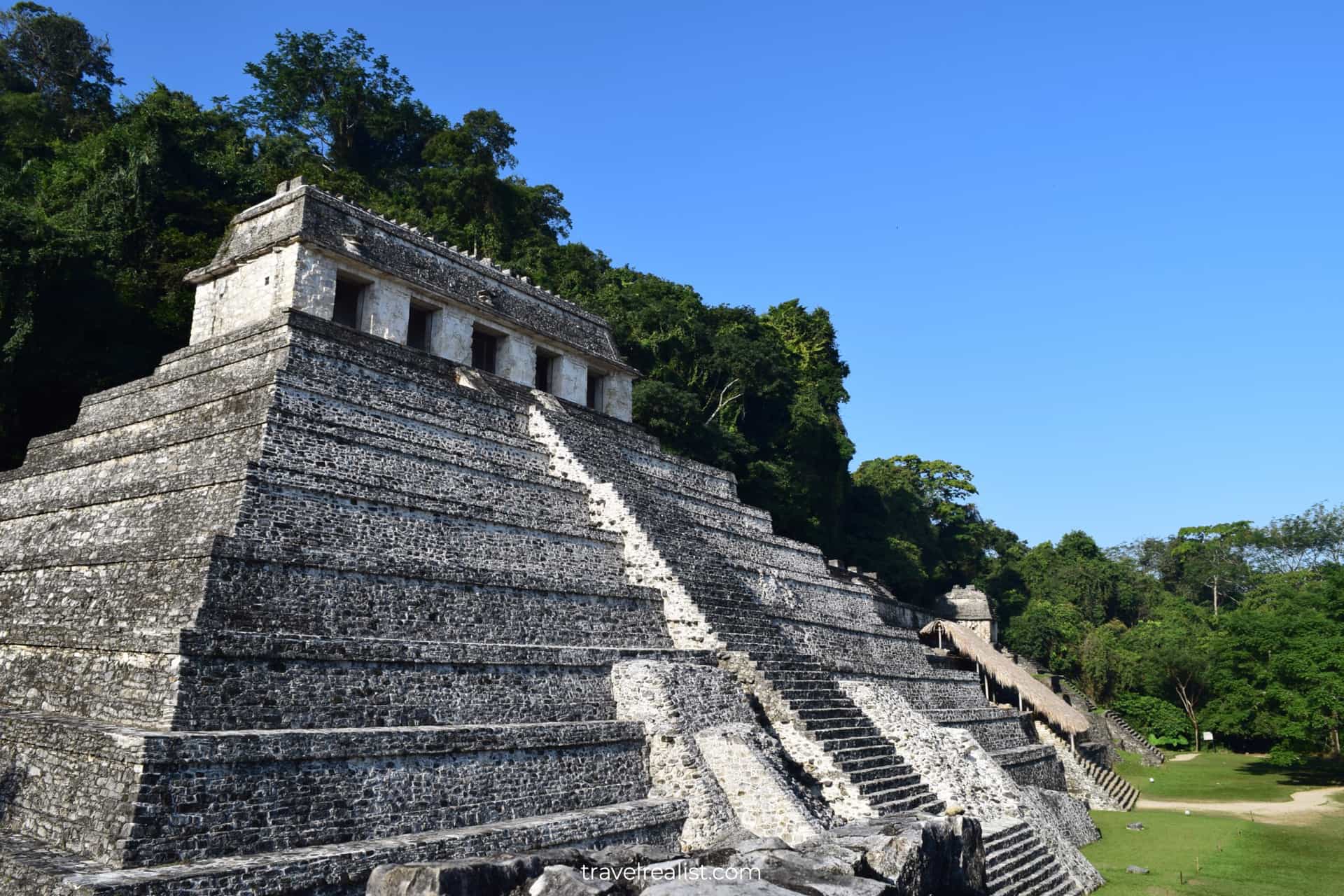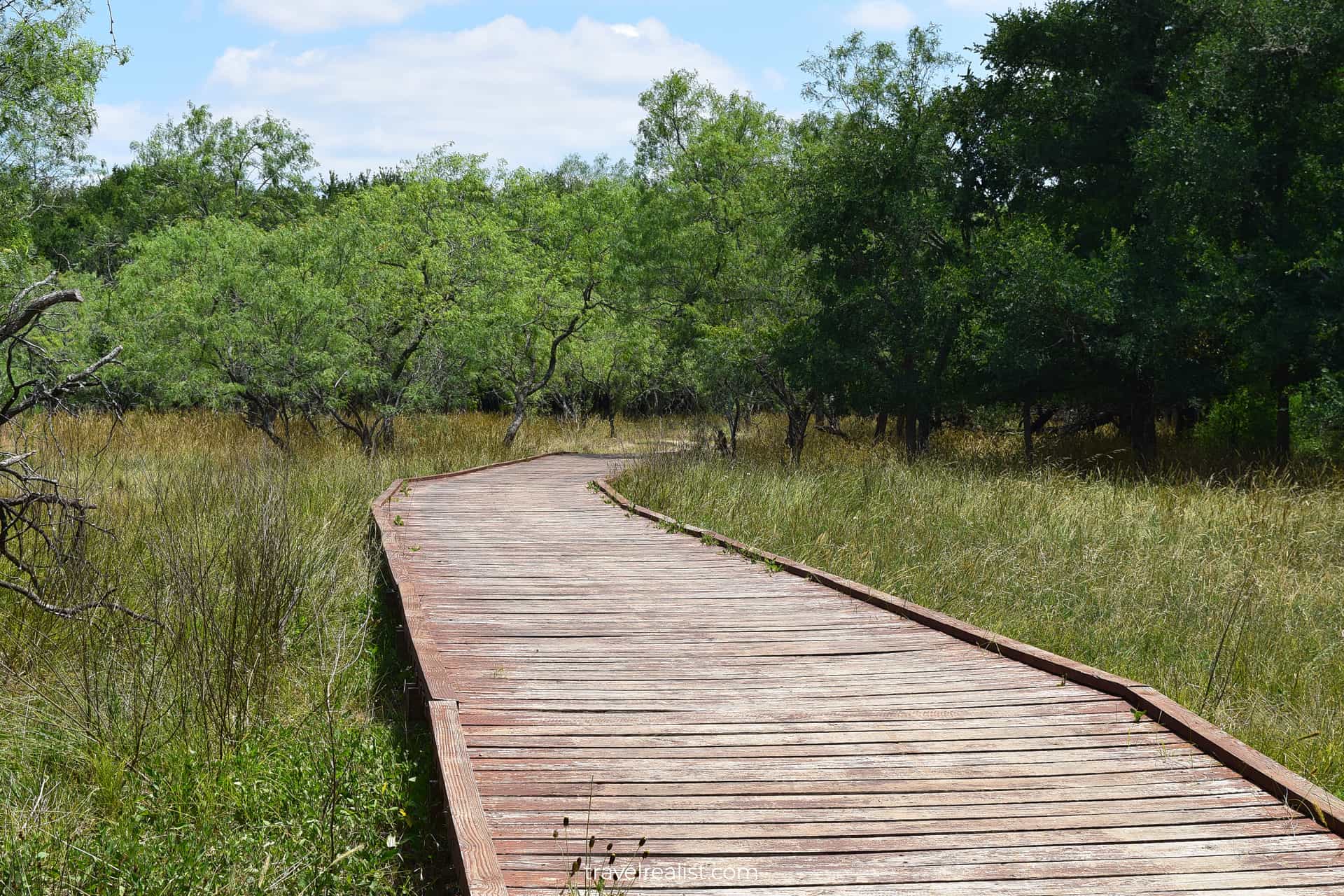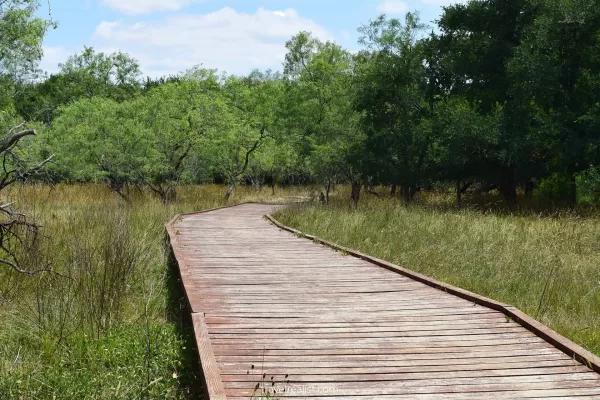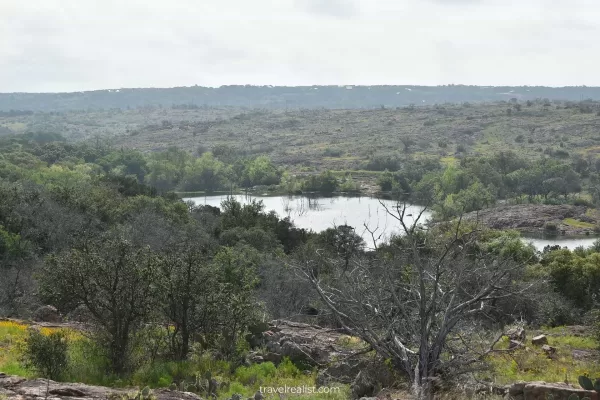Kenai Fjords: Wildlife Cruise Guide
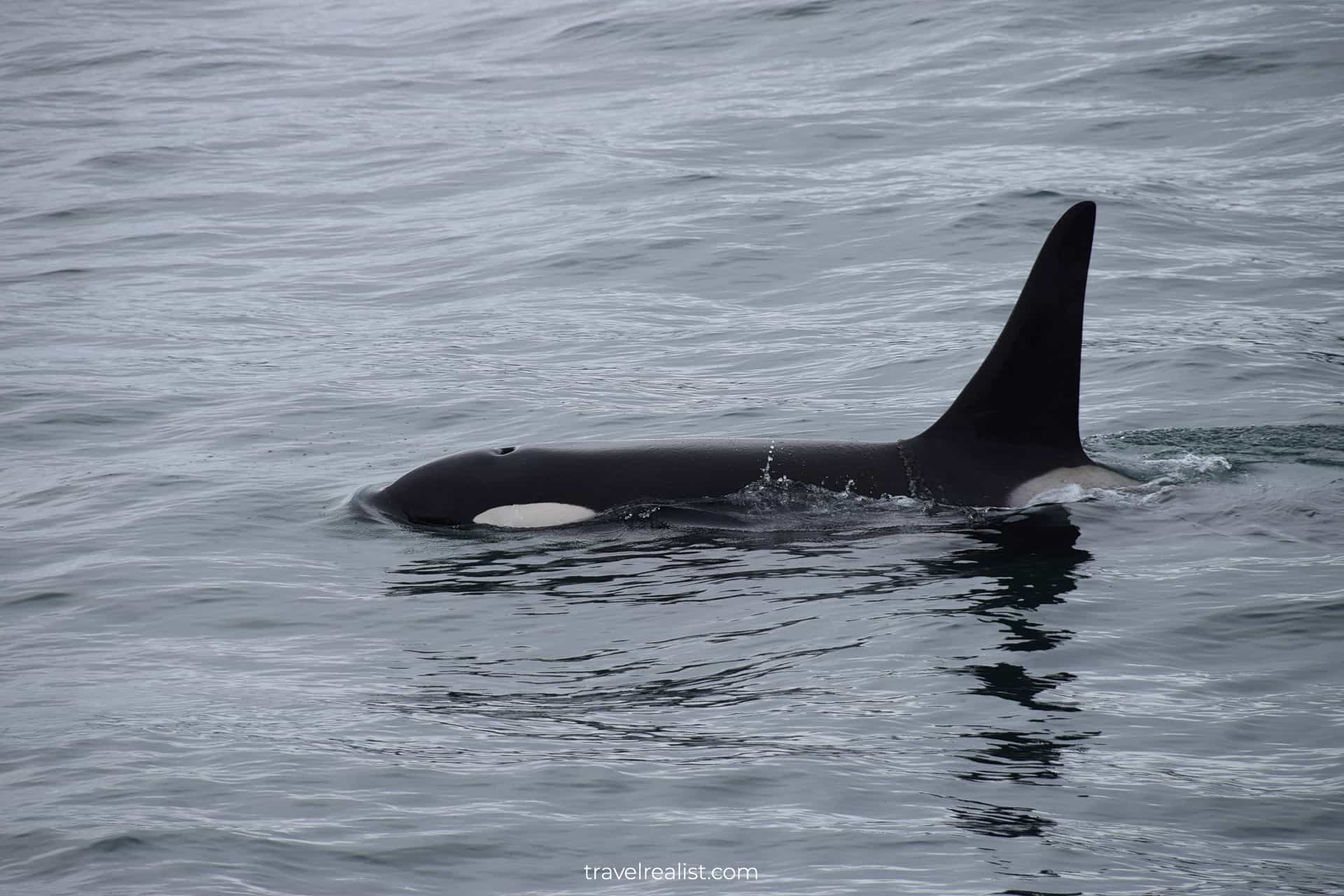
This realistic Kenai Fjords Wildlife Guide helps you plan your next adventure in this park.
Kenai Fjords National Park is a scenic destination. The park’s remote location makes a cruise a great way to spot the park’s wildlife.
This post includes affiliate links that will earn us commission if you make a purchase via these links.
Kenai Fjords Wildlife
Most tourists board a cruise in Kenai Fjords hoping to see wildlife. To be more specific, everyone hopes to see whales. The park is home to humpback, finke, gray, and orca whales. But the whales are in the park waters at different times.
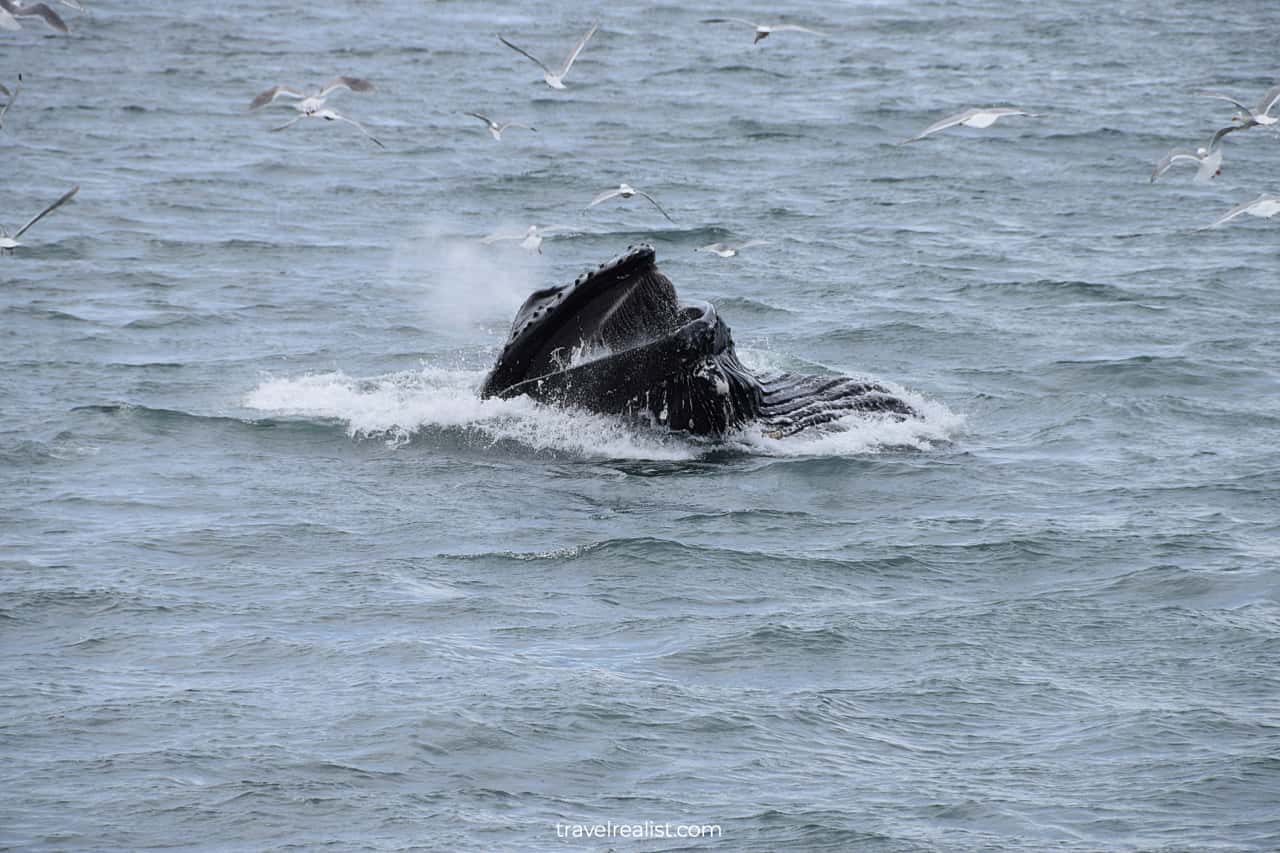
Kenai Fjords has a lot of other animals and birds to spot. You could watch sea otters, sea lions, harbor seals, and porpoises. Do not forget to look for bald eagles, puffins, and oystercatchers.
This section of the Kenai Fjords Wildlife Guide will describe different species you can spot in the park.
Sea Otters
You should start your wildlife cruise by looking for sea otters. These creatures live in Seward Boat Harbor. You have the best chances of seeing otters just after the cruise begins.
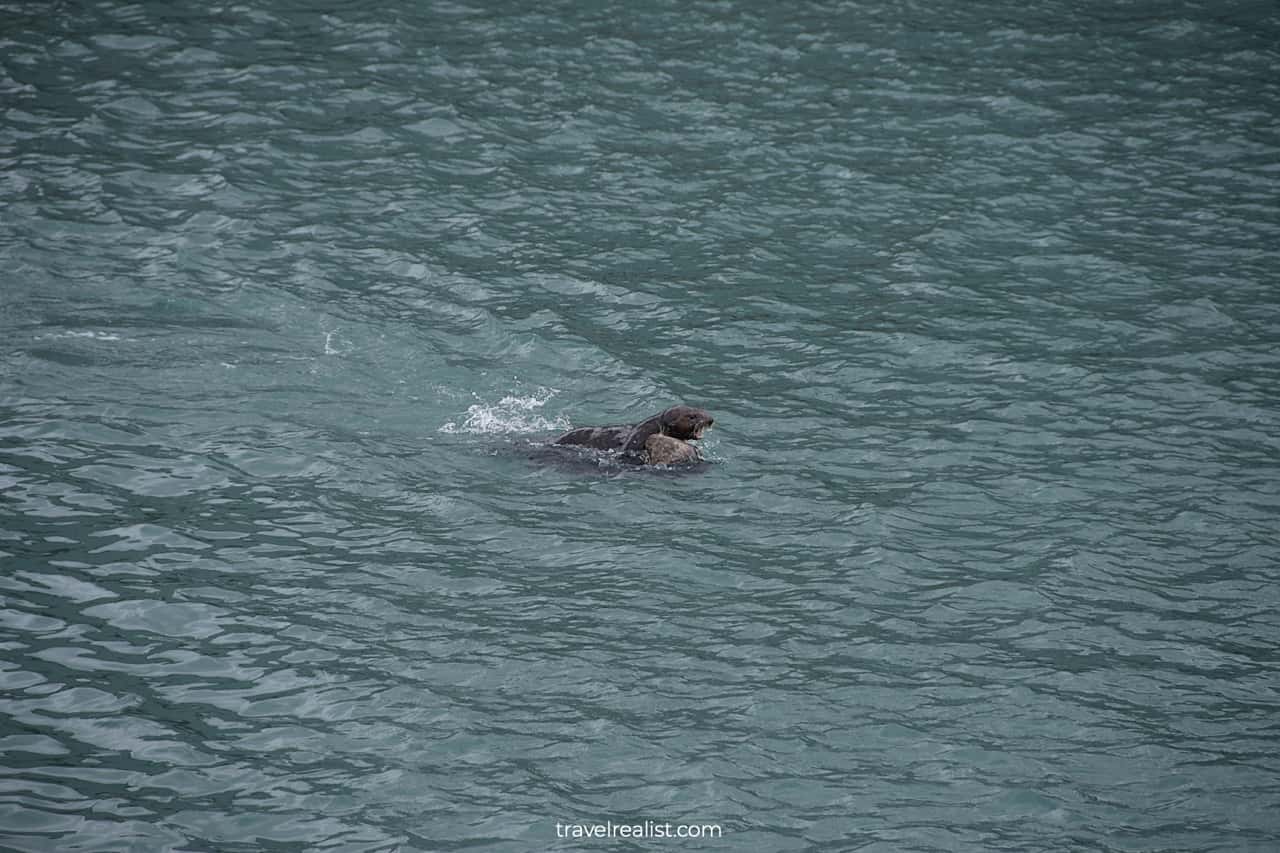
If you see otters, you are in for a treat. These marine animals often swim on their backs.
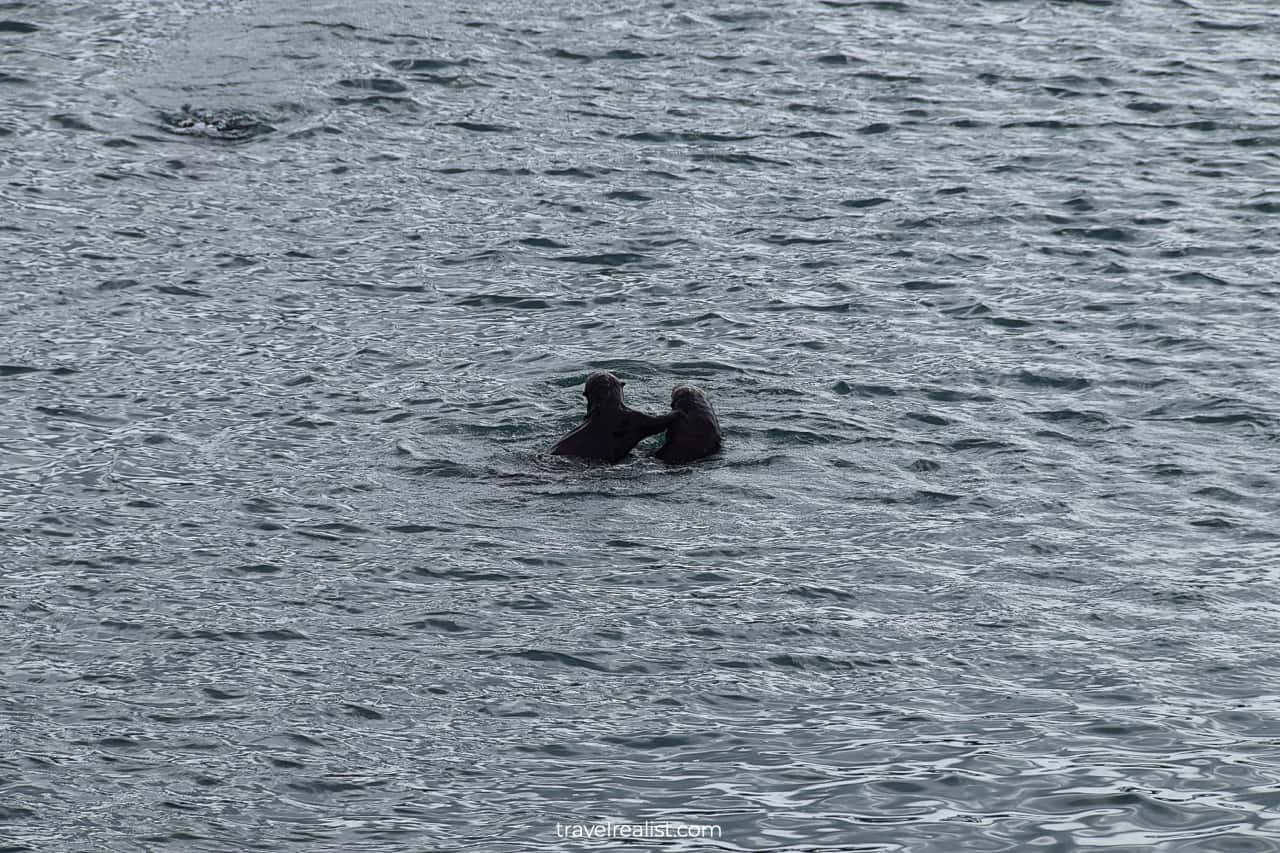
If you spot a group of sea otters, you could watch them fight and play with one another. The otters cannot outswim the boat. So you will lose them out of sight as the boat enters Resurrection Bay.
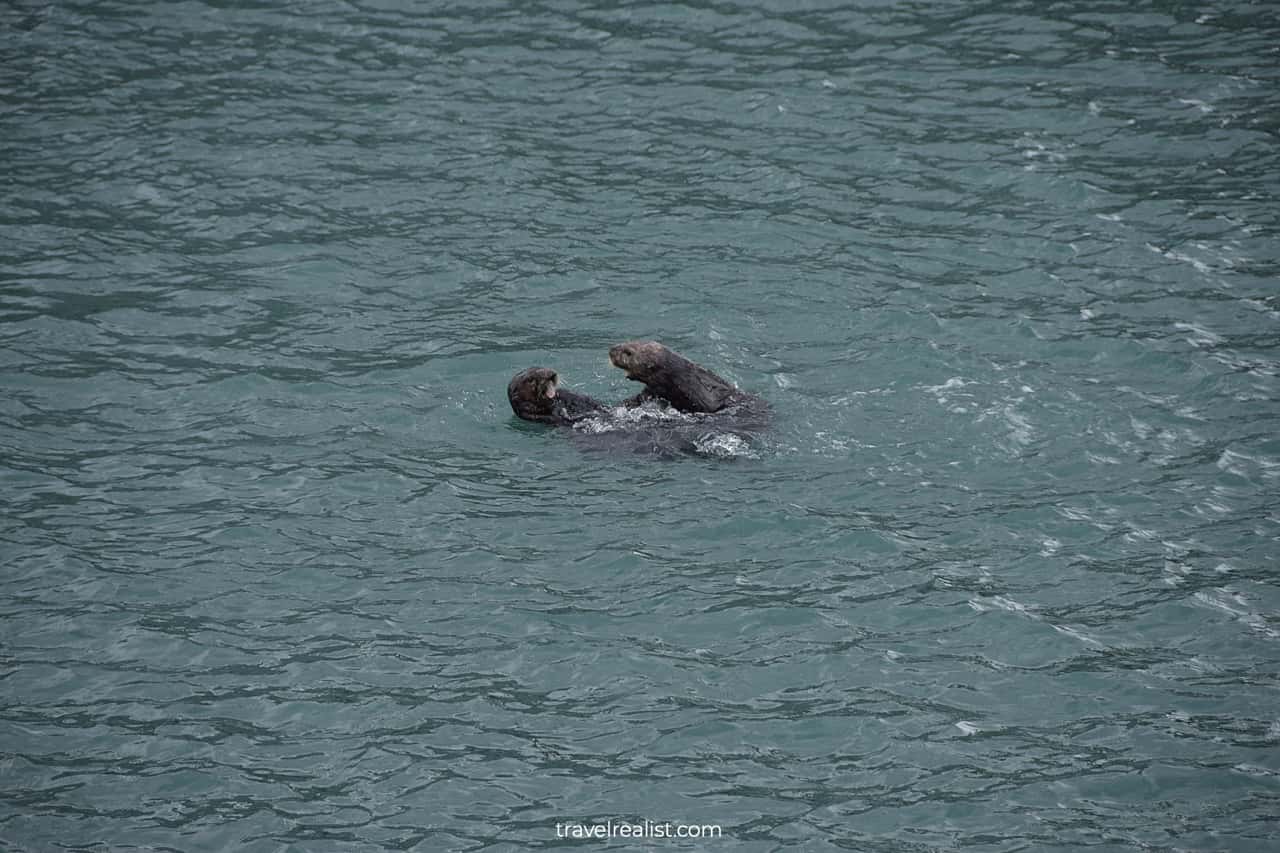
Humpback Whales
Kenai Fjords National Park is a great place to spot humpback whales. These massive mammals are a common sight in Alaska during the summer. It will likely not take you long to see your first humpback whale on this tour.
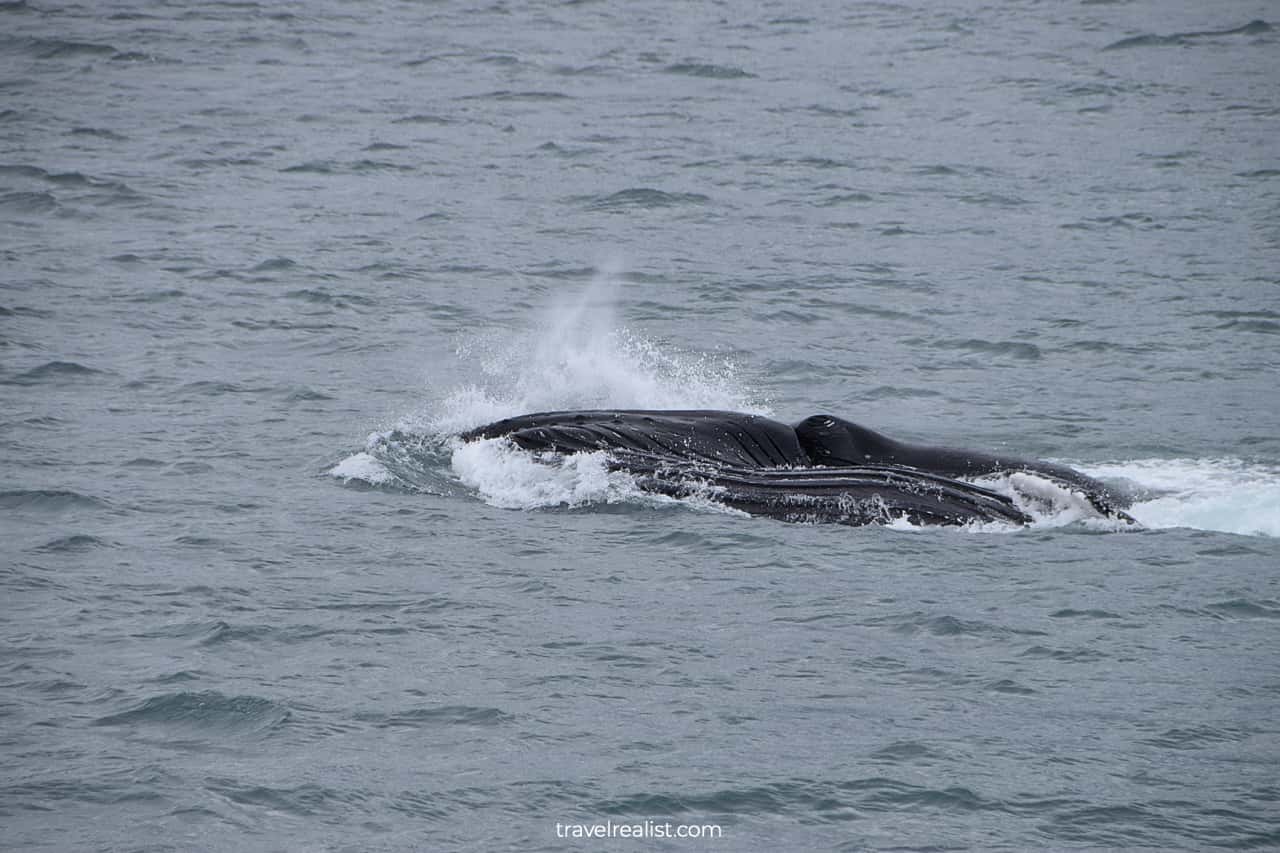
Your chances are the highest if take the tour between May and August. Most humpback whales migrate south from Alaska during the colder months.
You would want to go whale watching in Hawaii and Channel Islands near Los Angeles in the winter.
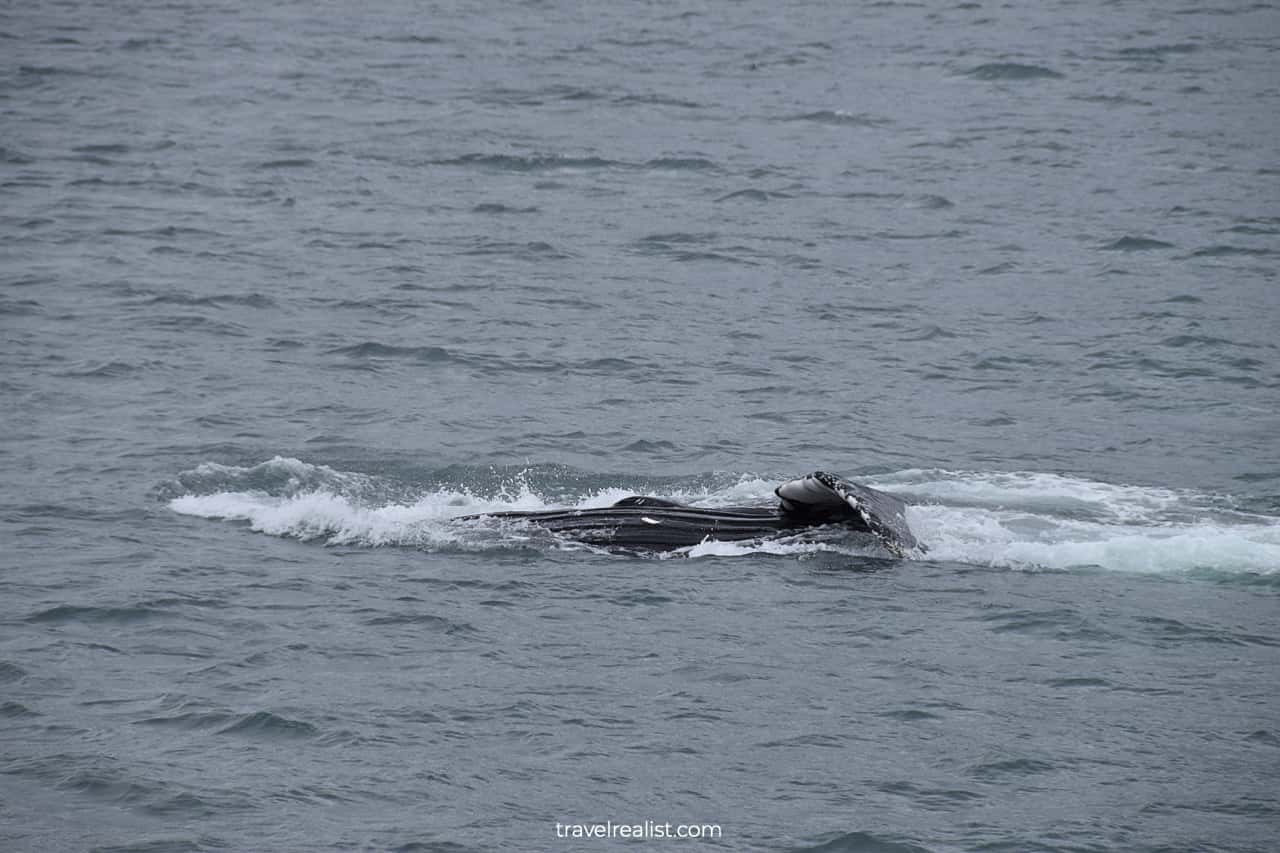
Timing is of great importance when whale watching. You usually have about a minute to watch a whale each time. After that the whale goes for another dive.
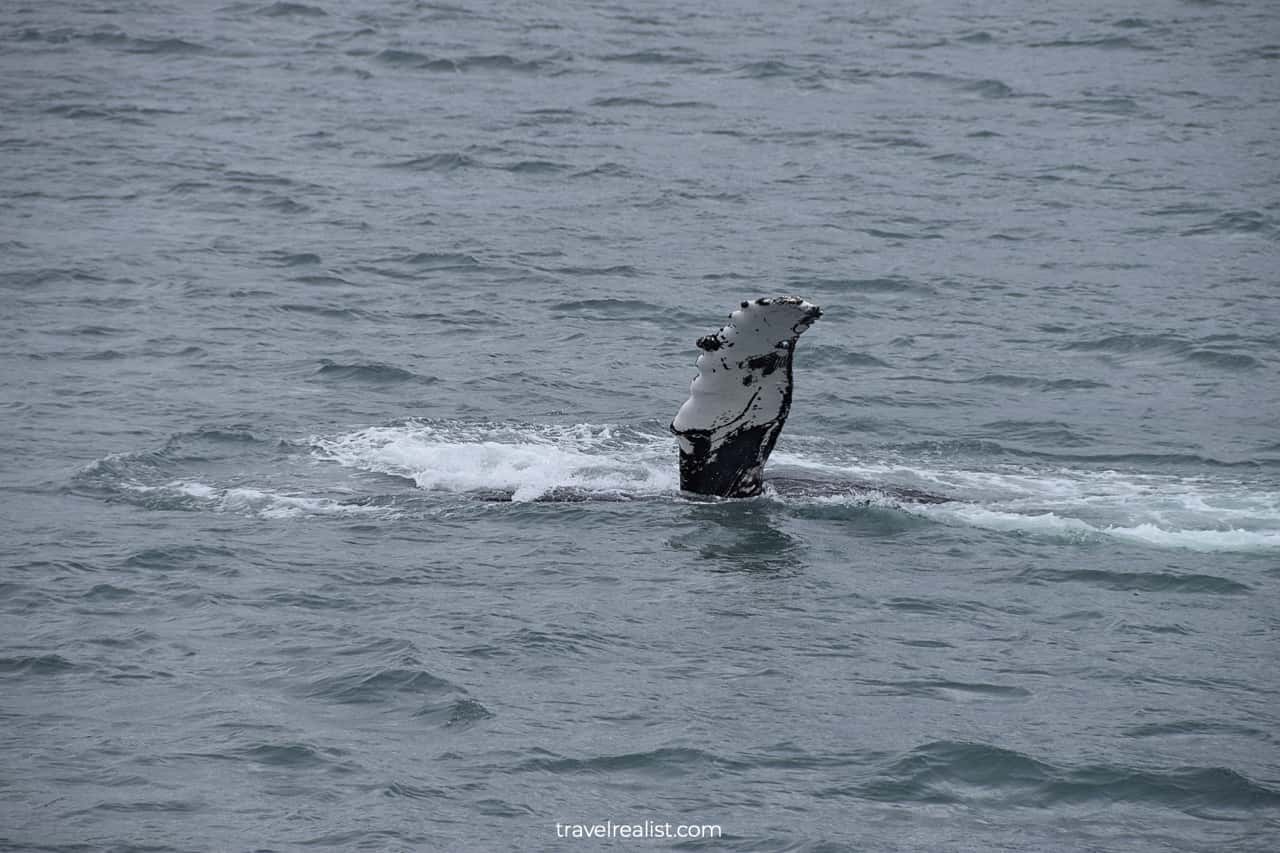
A dive can last anywhere from a few minutes to about an hour. The tour crew will be tracking this and other whales nearby during this dive.
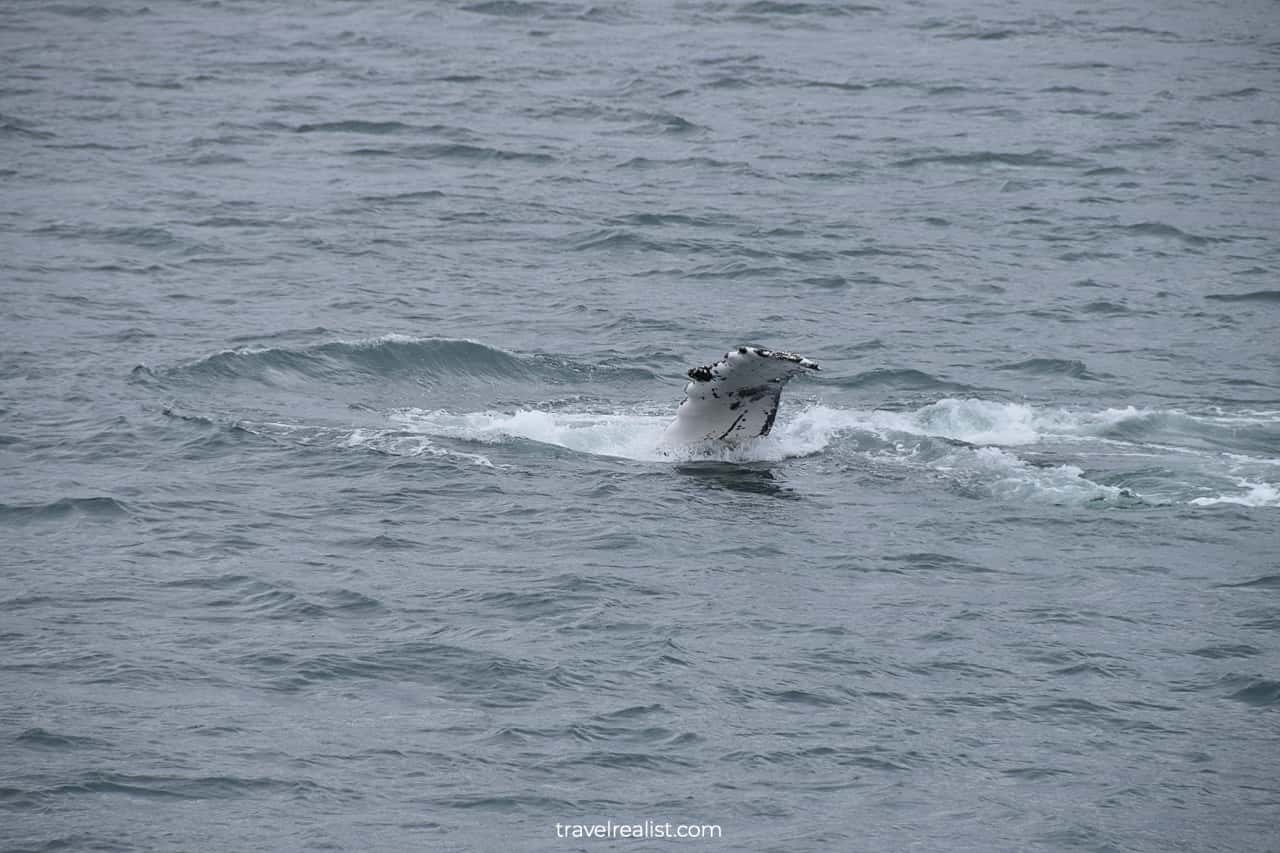
Seagull
But you can do your part by tracking seagulls. Nobody takes a wildlife cruise hoping to spot seagulls. You can easily see these birds in the harbor and all over seaside destinations.
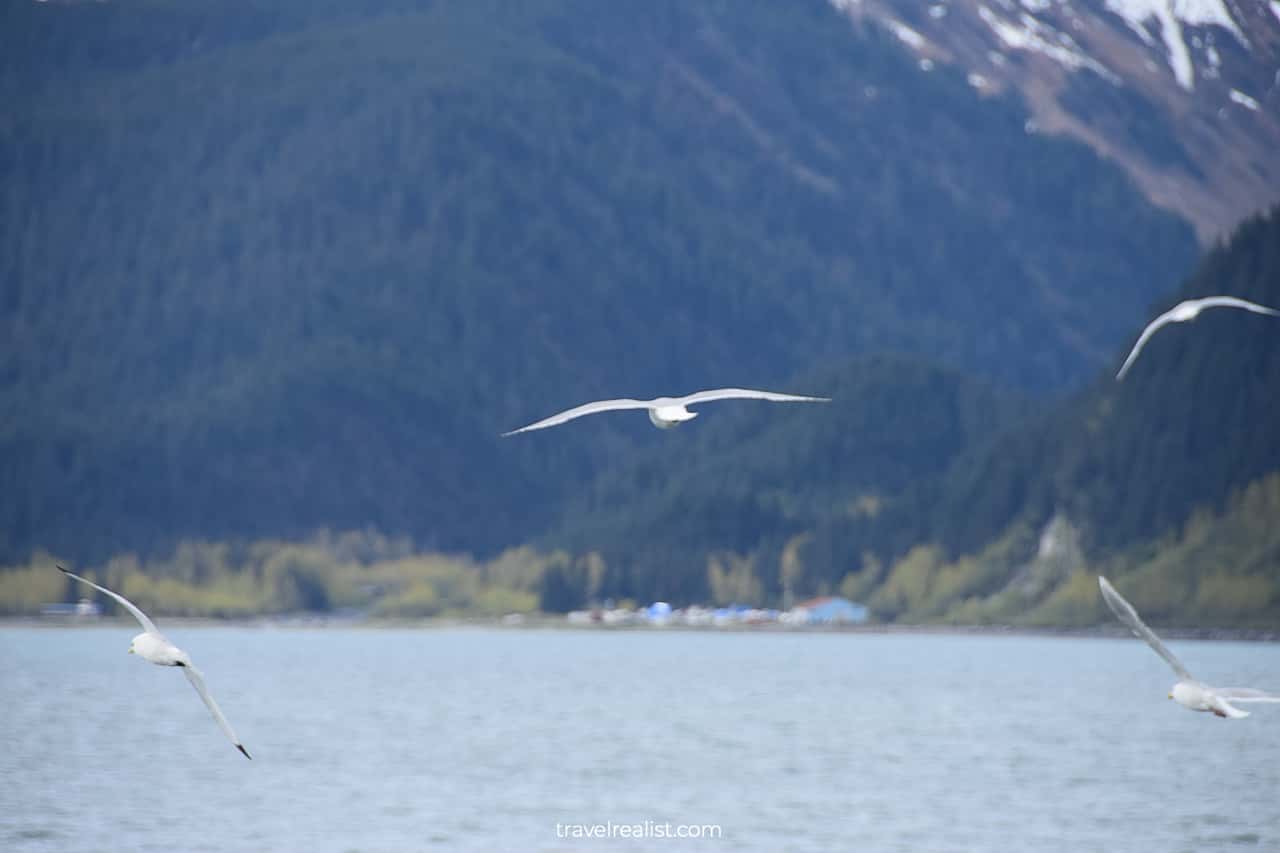
But these birds have an ability to predict where a whale will resurface. So take a note if you see a lot of seagulls gathering around one place. It is very possible that a whale will reemerge there in a few minutes.
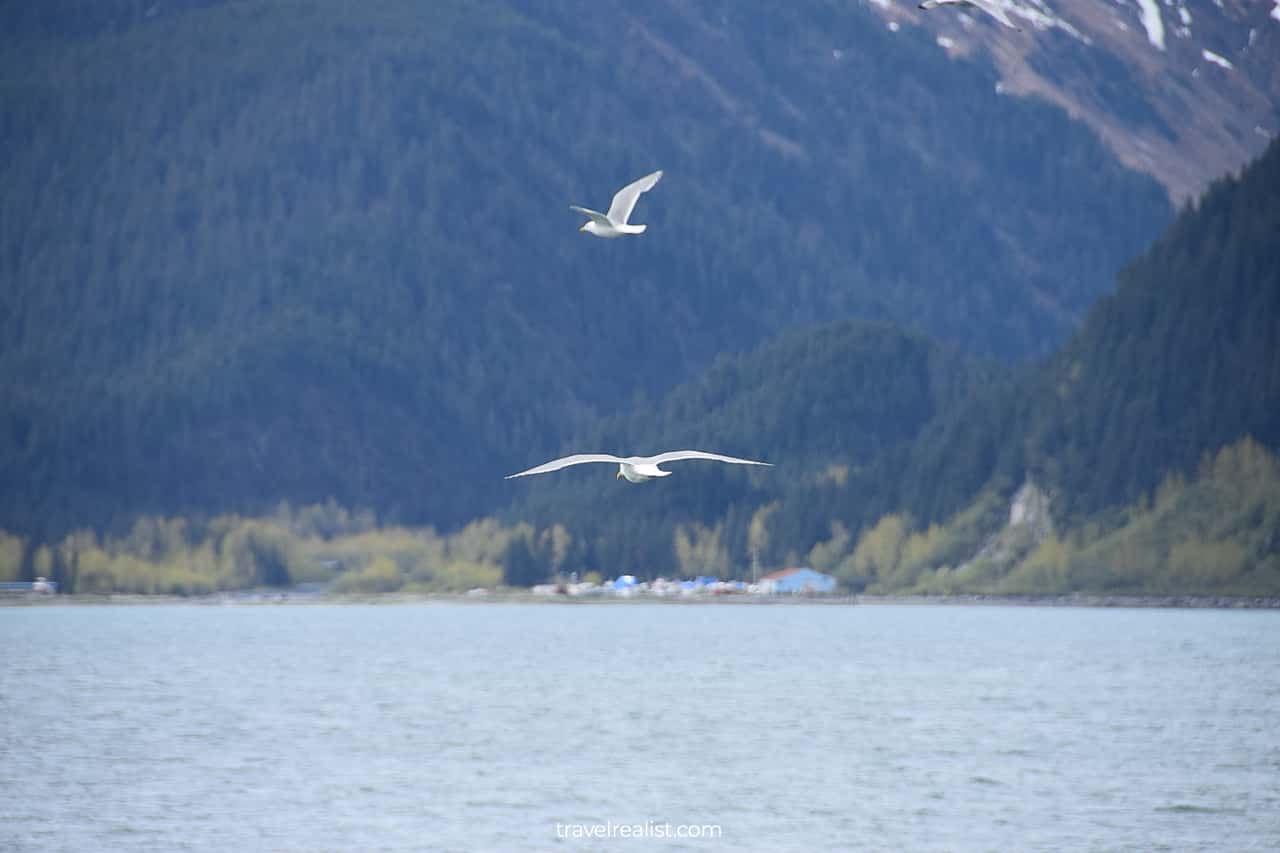
This observation proves true again and again. Even it fails to deliver, you will have something to do while waiting for the next whale.
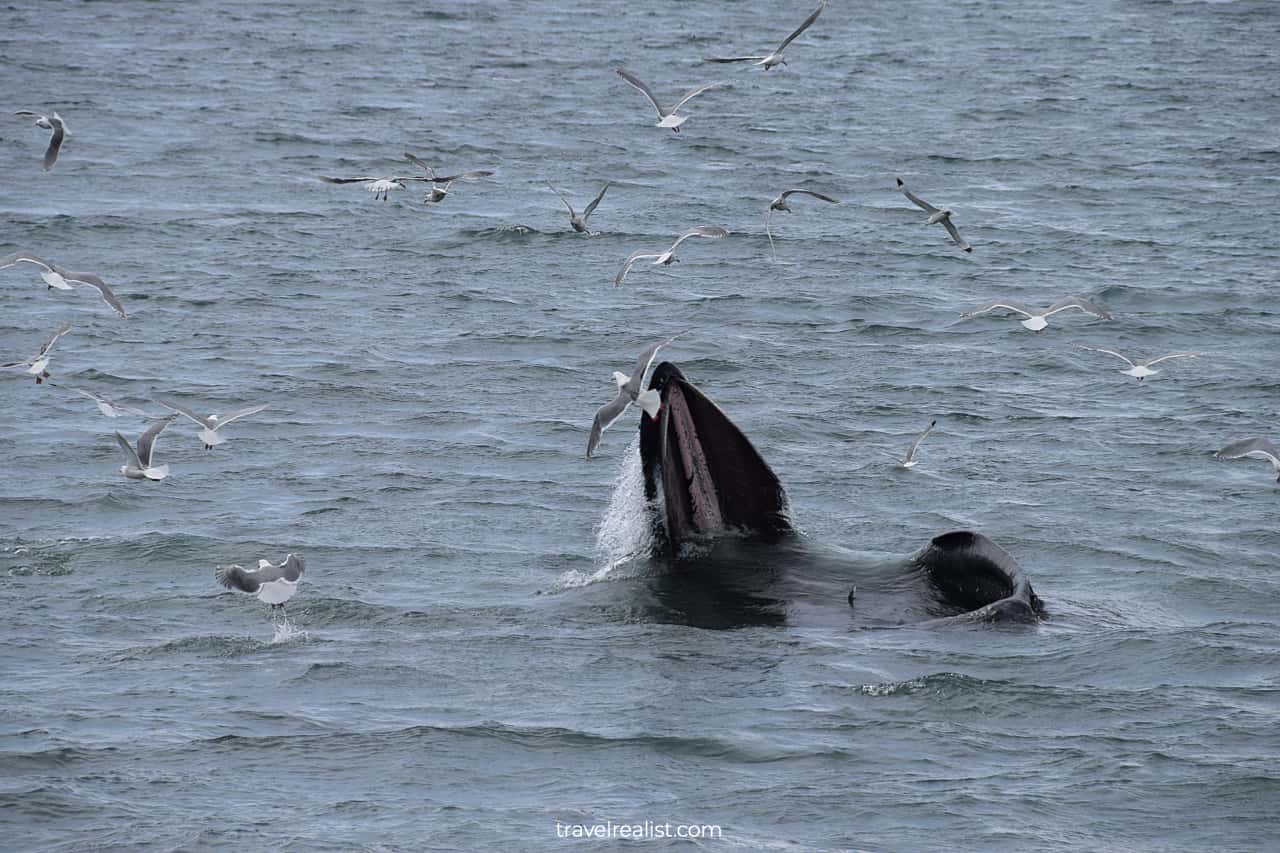
The moment a whale reemerges from the water is key. The tour guides will let you know once it happens. But if you are on the other side of the boat, you might not be fast enough to see it.
So having a head start on your fellow travelers helps. You could capture this moment on photo or video.
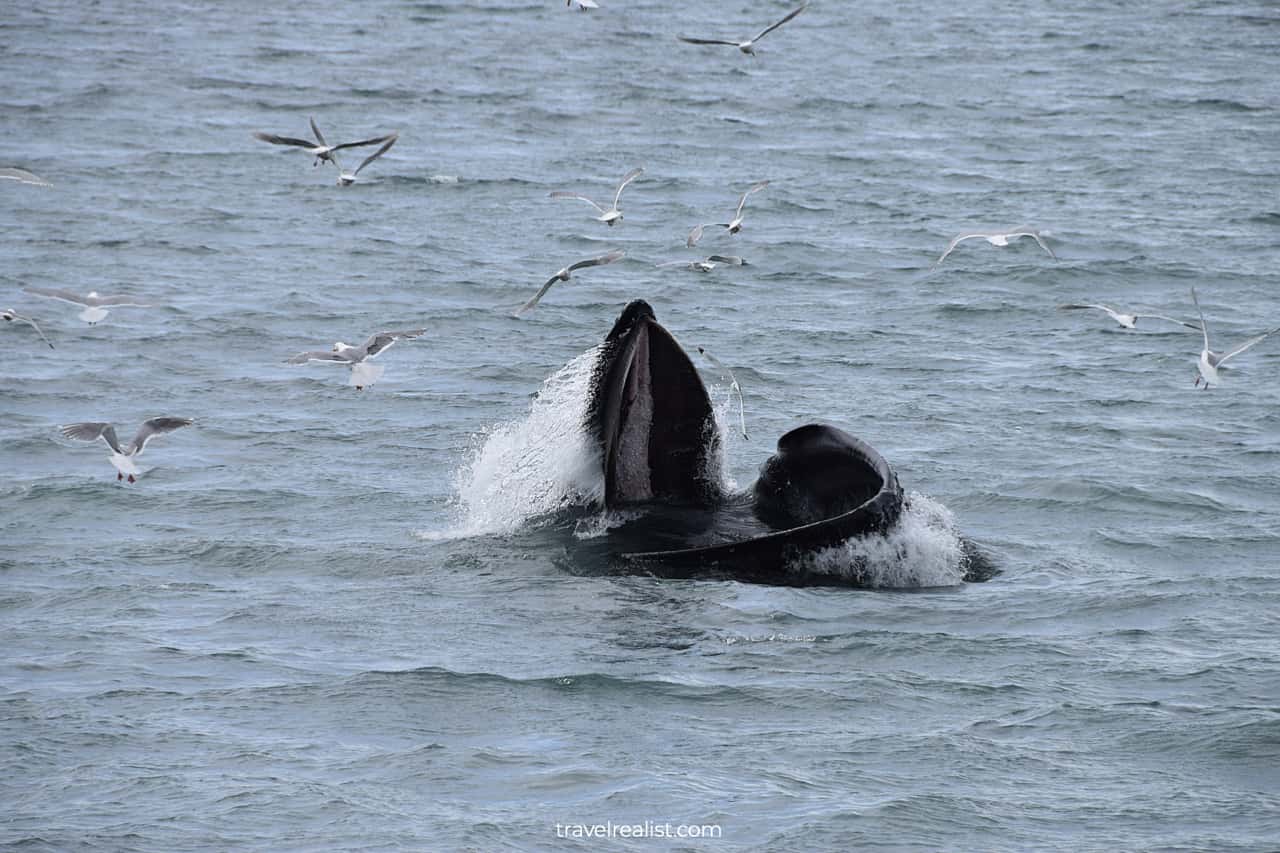
You might get lucky. In this case you would see a whale jumping out of the water. Or you could observe a whale quickly close its mouths. The seagulls will be flying away to escape an accidental trap.
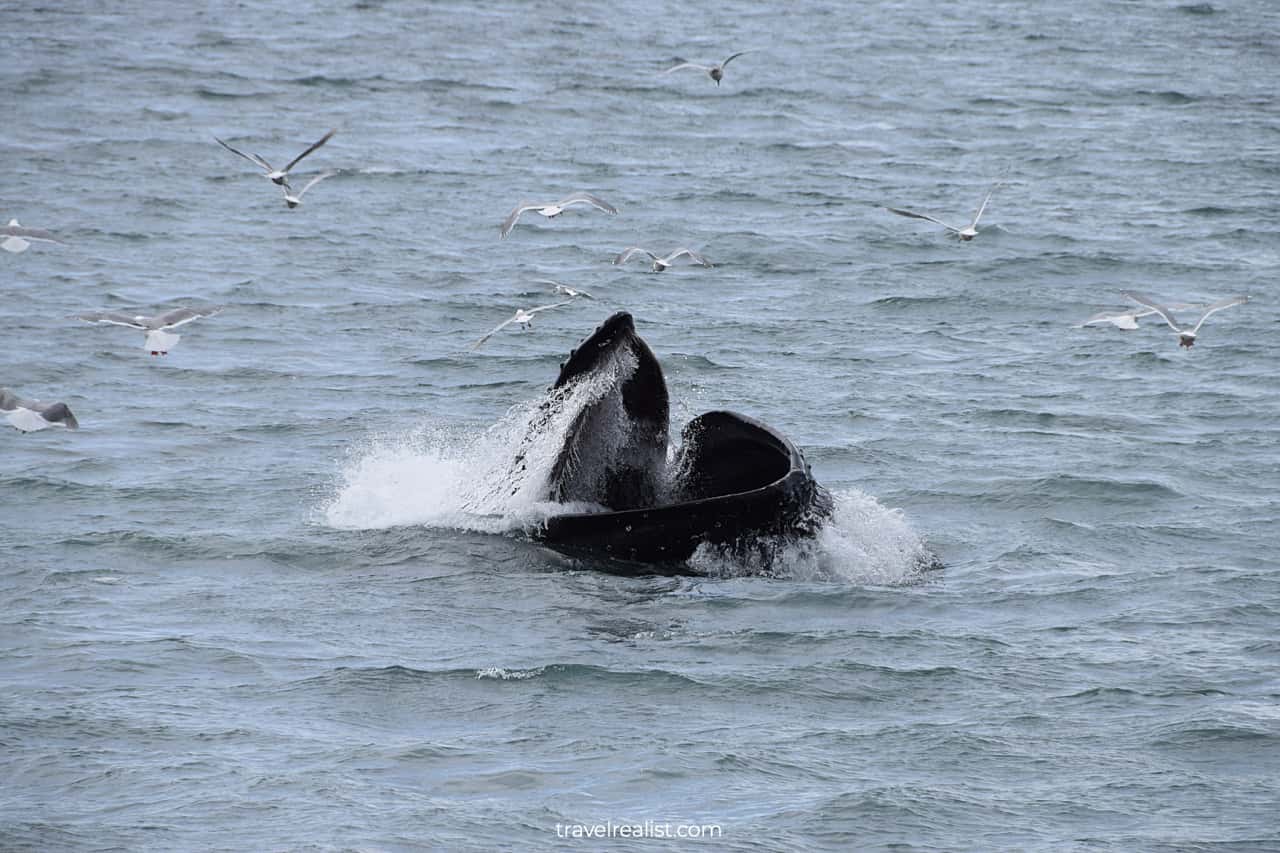
A whale completes this move within seconds. A slightly more common behavior includes spouting. The whale will start preparing for the next dive soon after. Watch out for the fluke dive.
Finke Whale
You might also see finke whales in addition to the humpbacks. But your chances vary even during the best season between May and September. You might want to take a Boston Whale Watching tour to see these whales instead.
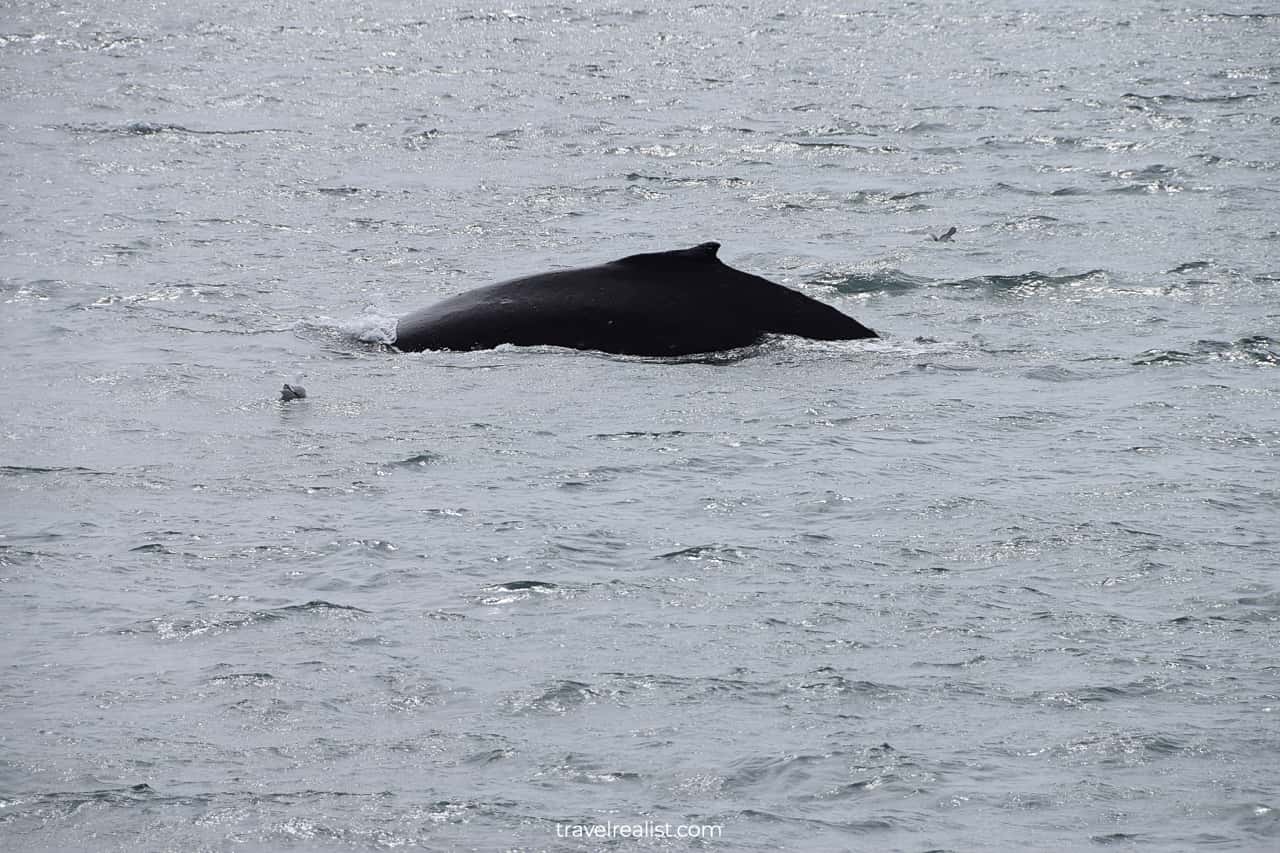
Gray Whale
You are least likely to see a gray whale on a Kenai Fjords wildlife tour. The animals migrate away from Alaska by late May. Your chances are slightly better in the spring.
But many places of interest in Alaska will not be open then. So decide for yourself if an early spring trip to the state is worth it.
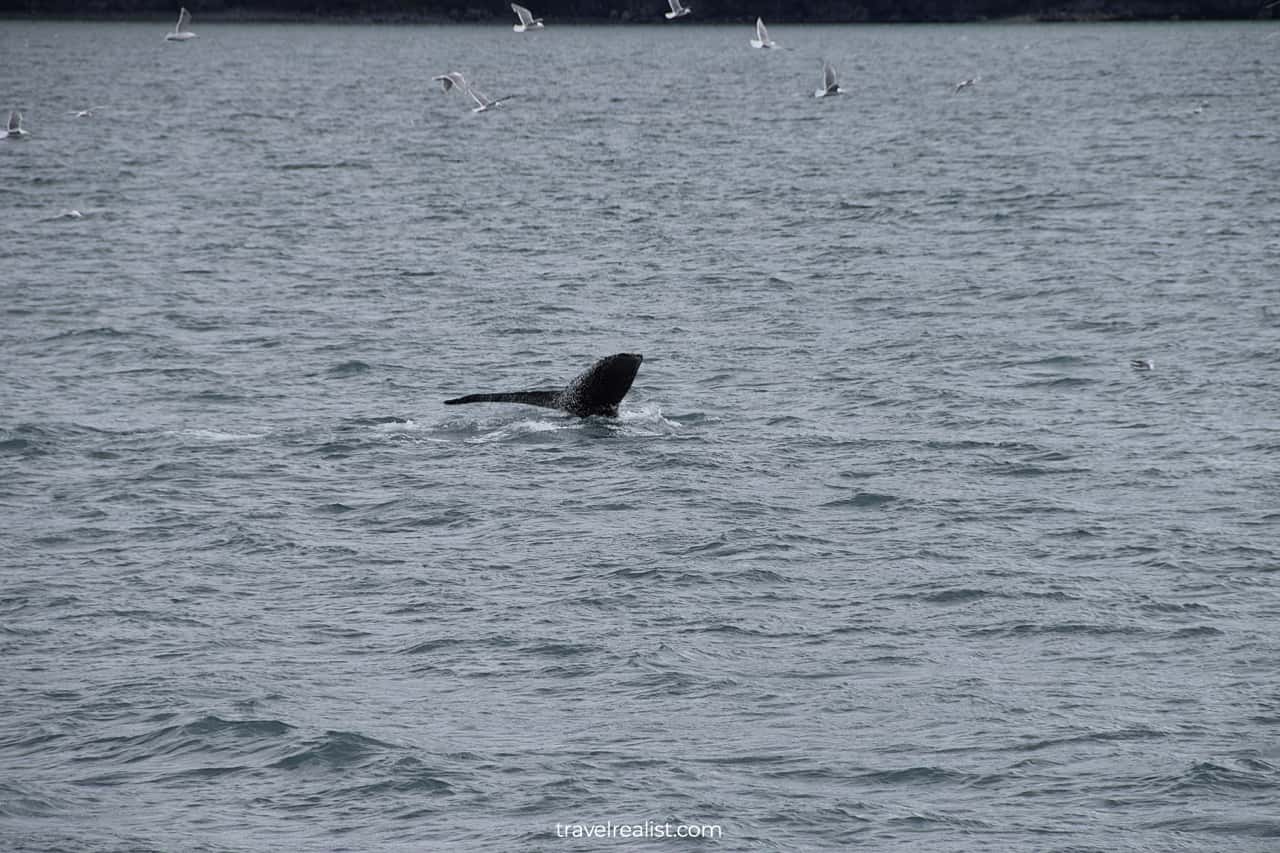
Bald Eagle
The cruise will devote about an hour to whale watching in the Bay. Your mileage may vary. But you can expect to see at least a couple of whales. They will go for dives and resurface.
The tour will then continue towards Bear Glacier.
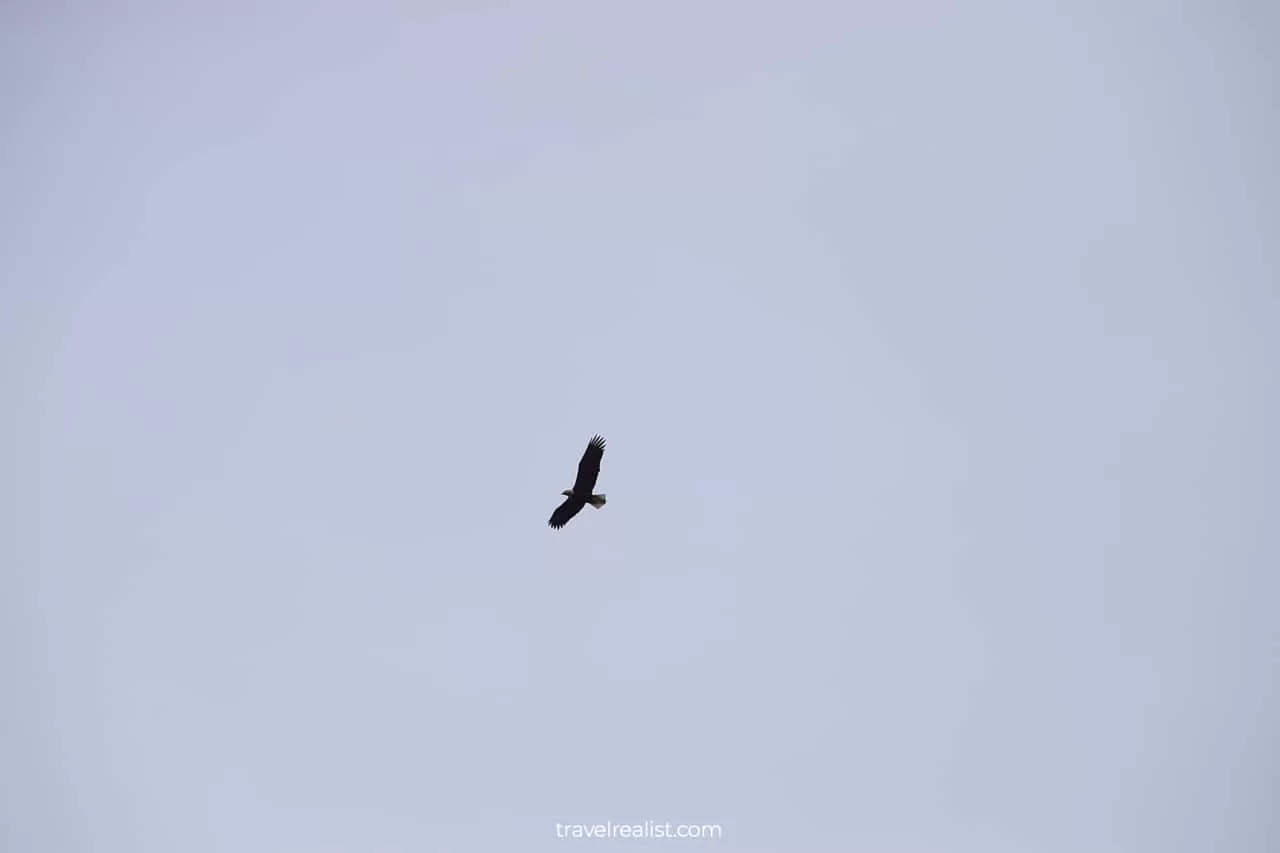
Marine birds will be the main animals to spot during this part of the cruise. Look for bald eagles, puffins, murres, and cormorants. The last bird in particular is quite common. You do not need to go to Alaska to see one. There are plenty in San Francisco Bay.
Orca
After a distant view of Bear Glacier, you could hope to spot orcas. These animals became popular after several movies in the 1970s and 1990s.
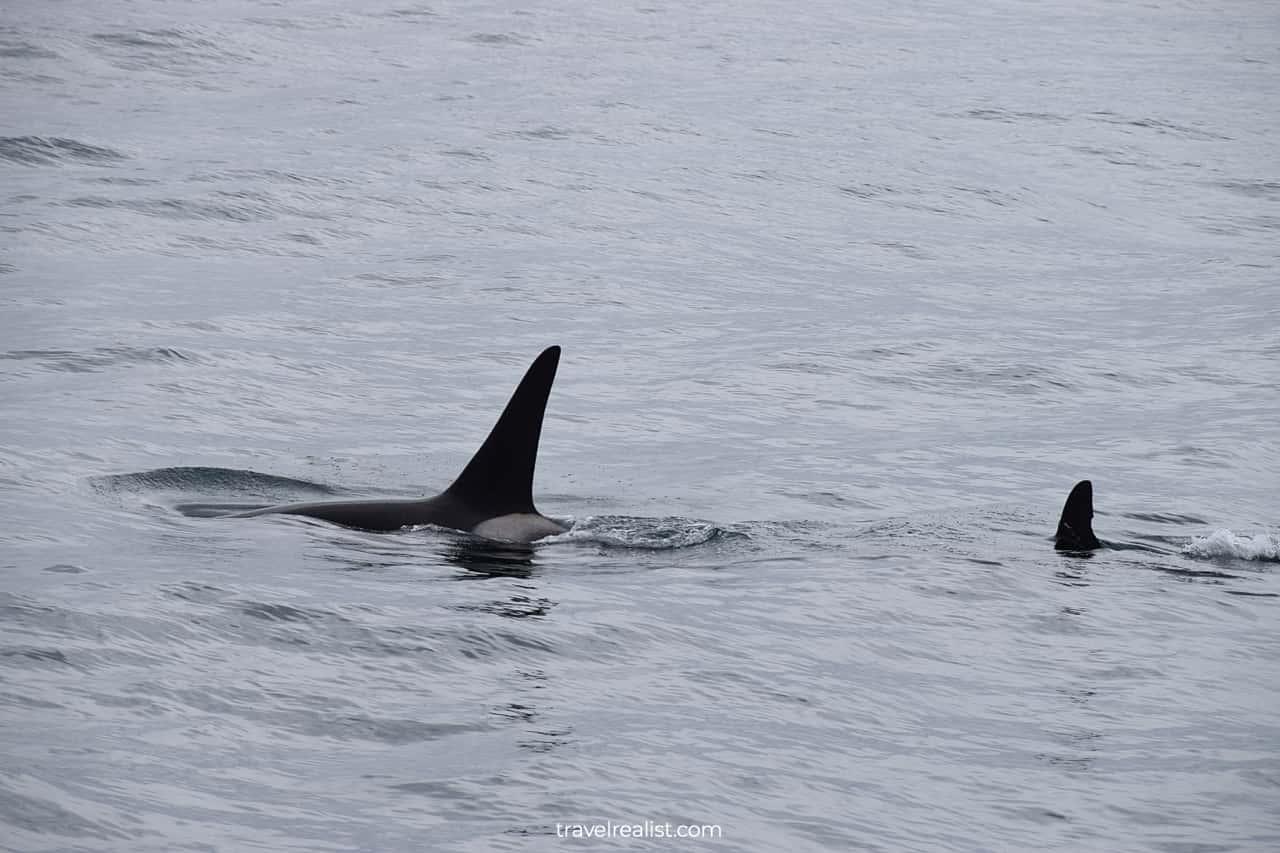
Orcas are killer whales. They feed off fish, seals, sea lions, and sharks. You can easily recognize orcas thanks to their white marks and fins. If you are lucky, the orcas will come close to your boat.
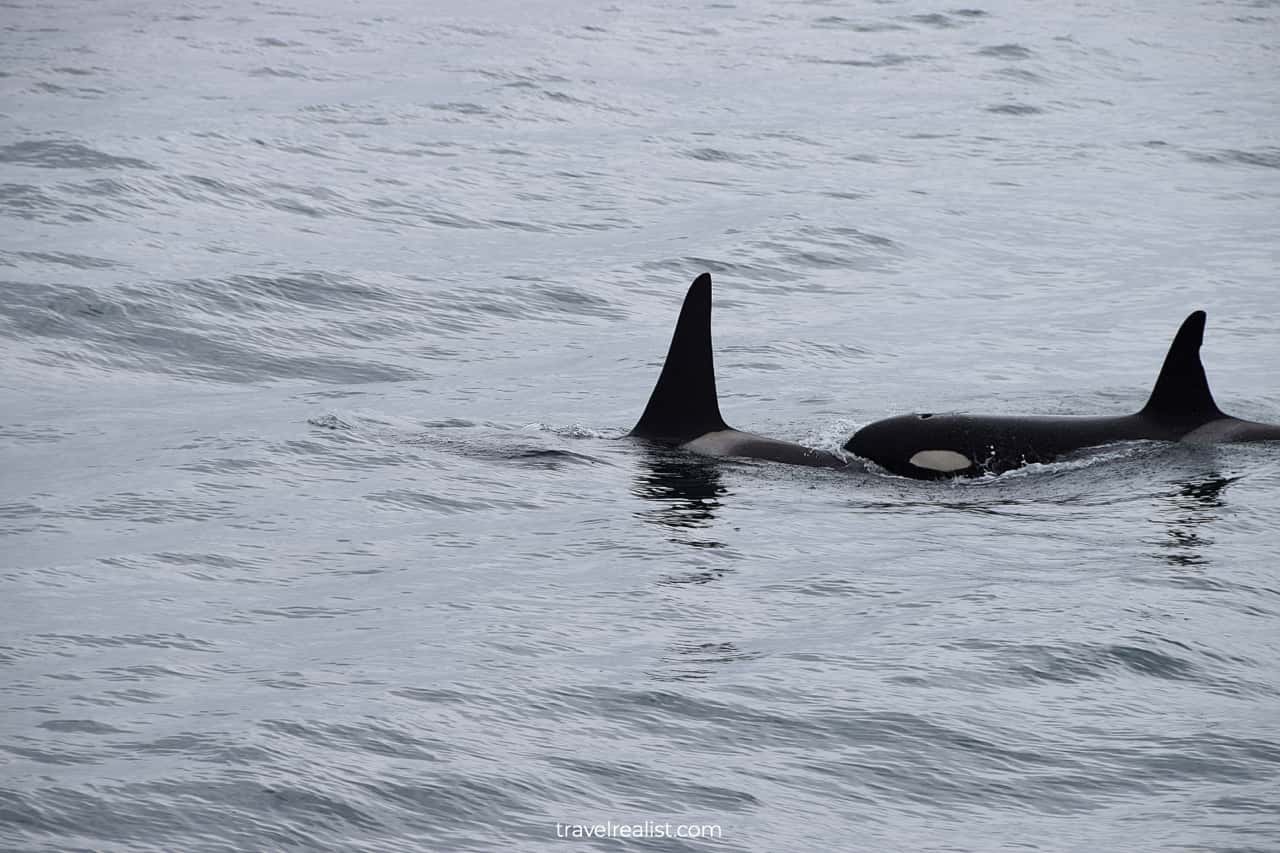
Orcas exhibit similar behavior to humpback whales. They stay near the surface for a minute or two. After that orcas go for a dive. And then they resurface a few minutes later.
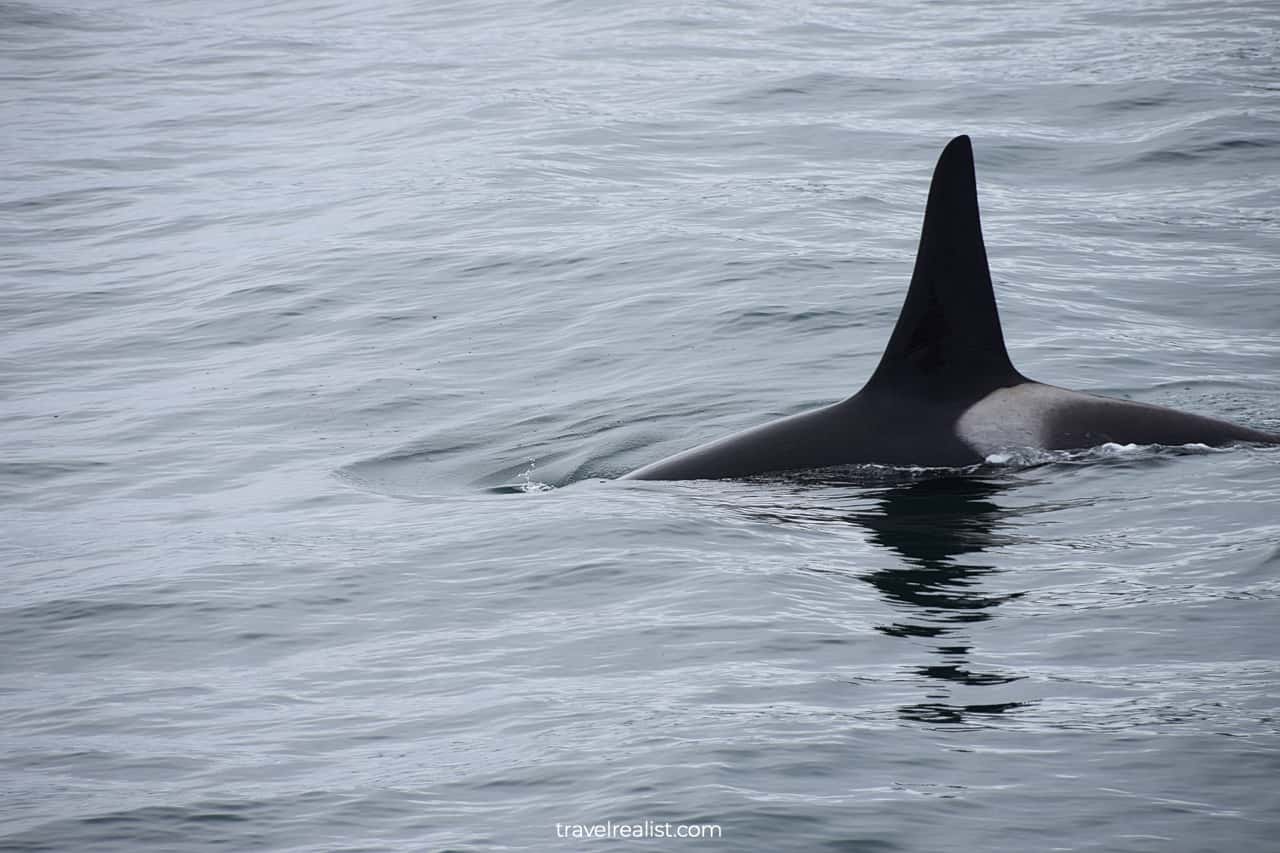
Orcas are smaller than humpback whales. But their tails are no less breathtaking when they go for a fluke dive.
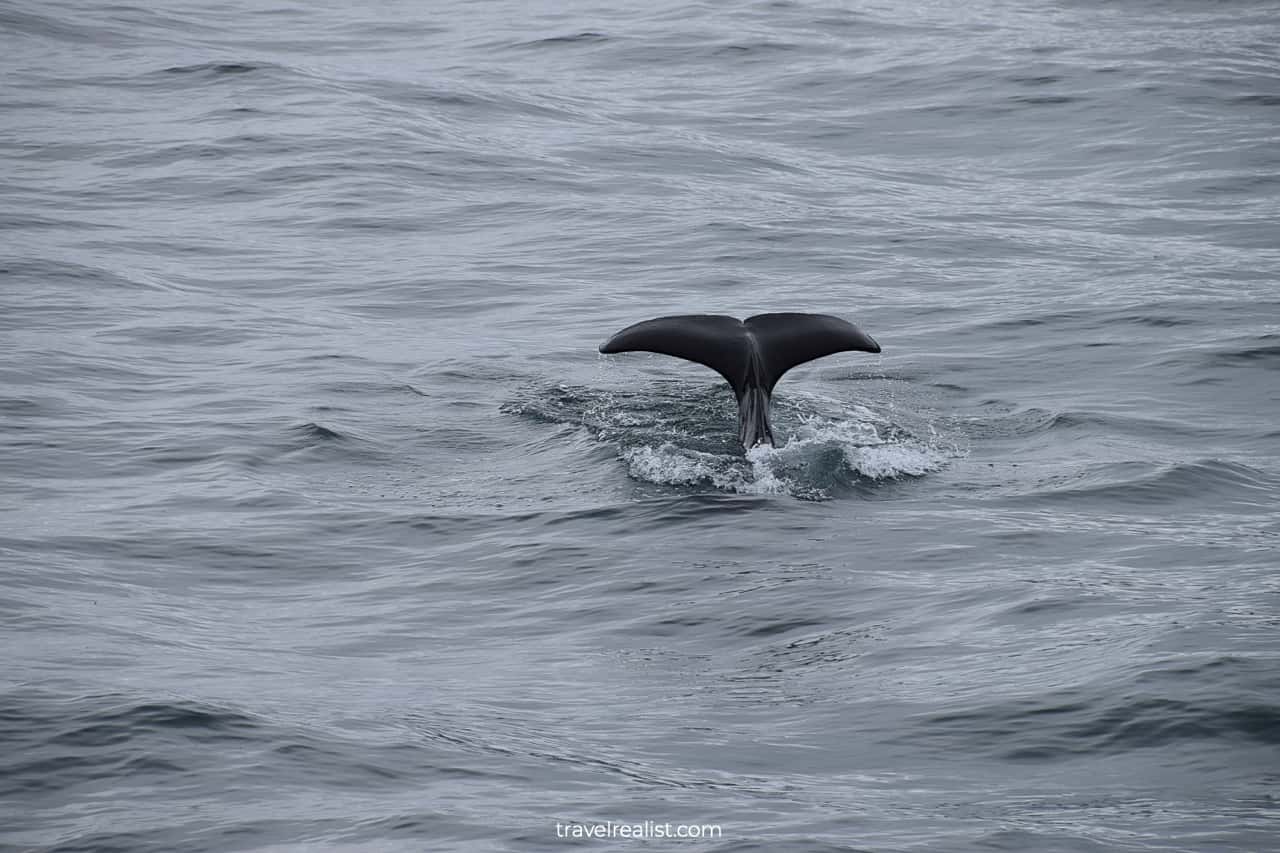
Whenever orcas resurface, be ready that the whole boat will run to see these animals up-close.
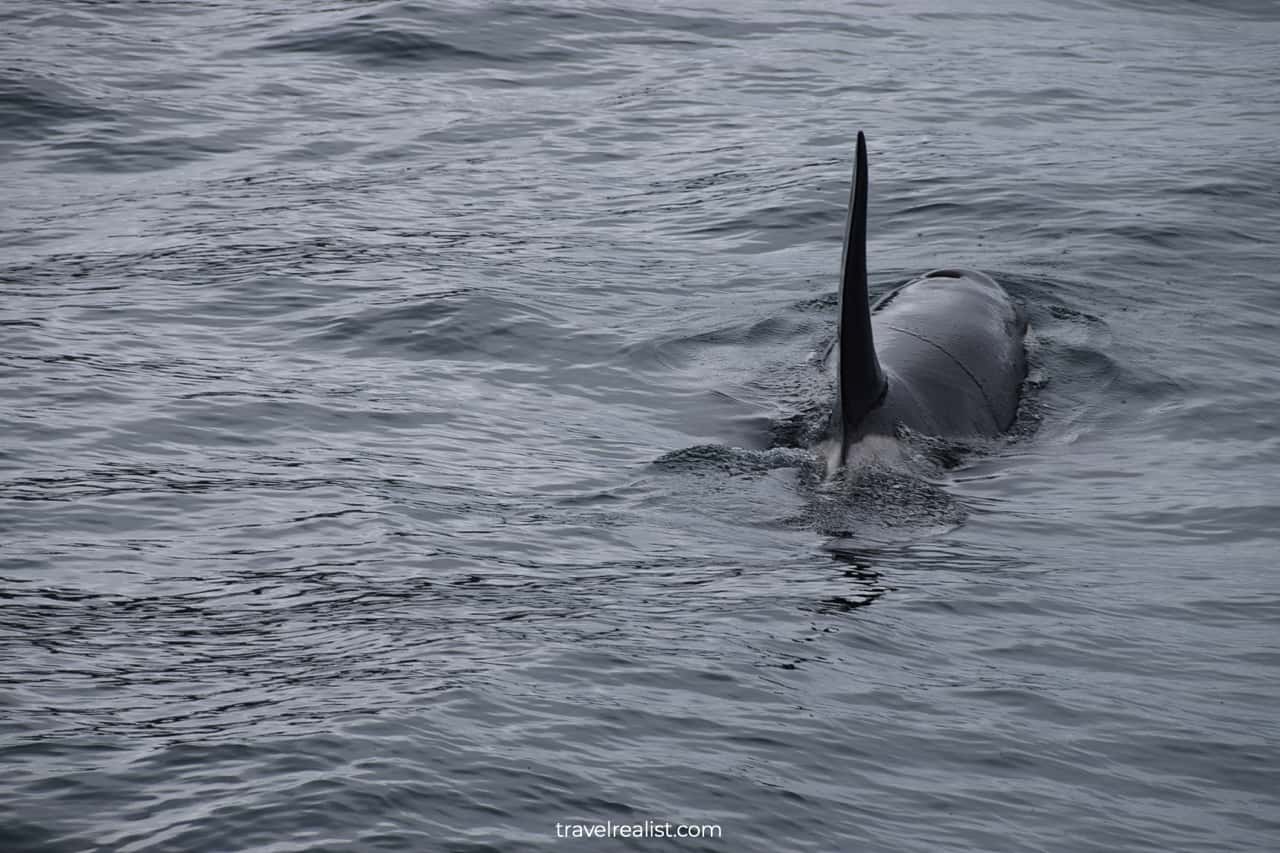
If you have a good enough spot you can capture an iconic view of an orca.
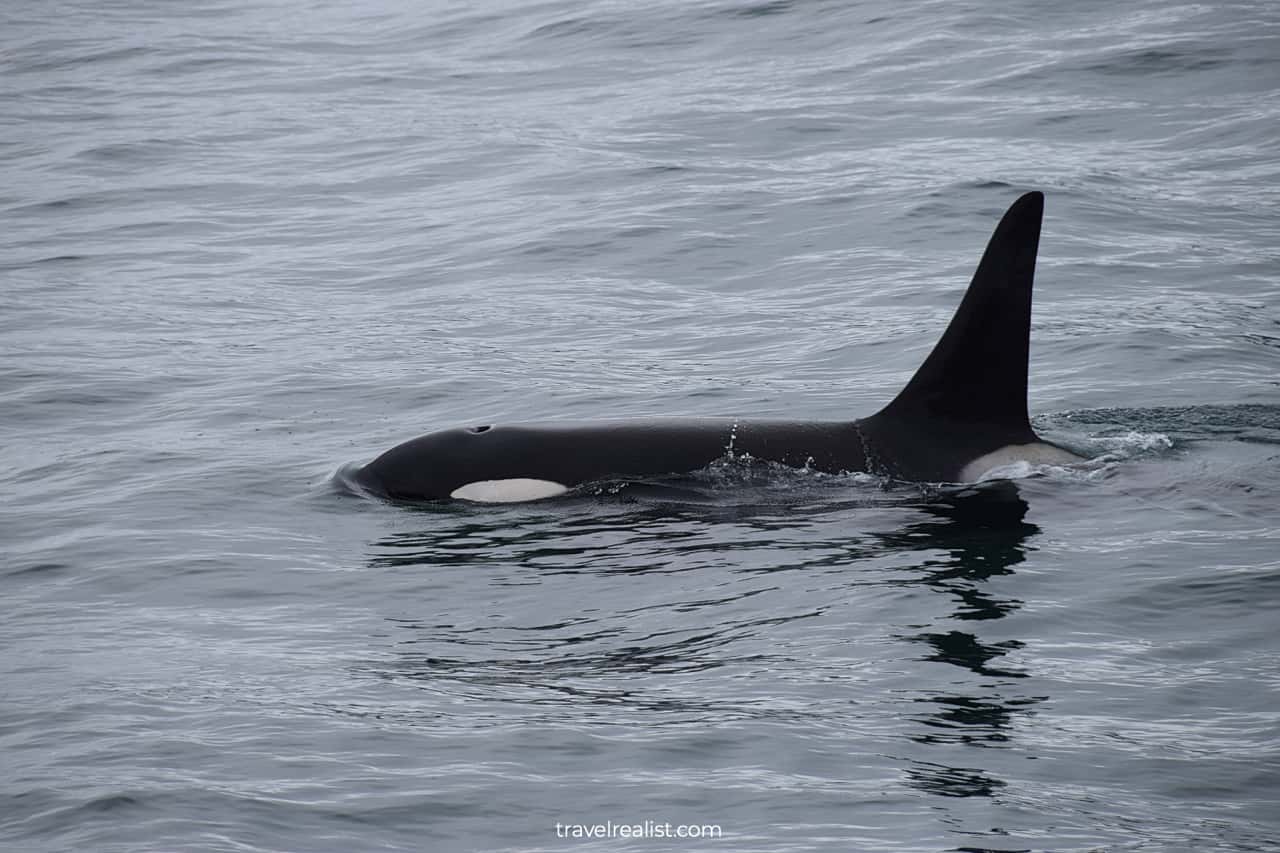
Orcas hunt in different parts of the Bay. The cruise might have to change the route slightly to find them. In this case, the captain might need to make up time. When the boat goes faster, it experiences more turbulent seas. Plan for this possibility if you are prone to motion sickness.
Sea Lions
Most cruises will then bring you to a colony of sea lions. These animals live on the Rugged, Hive, and Fox Islands.
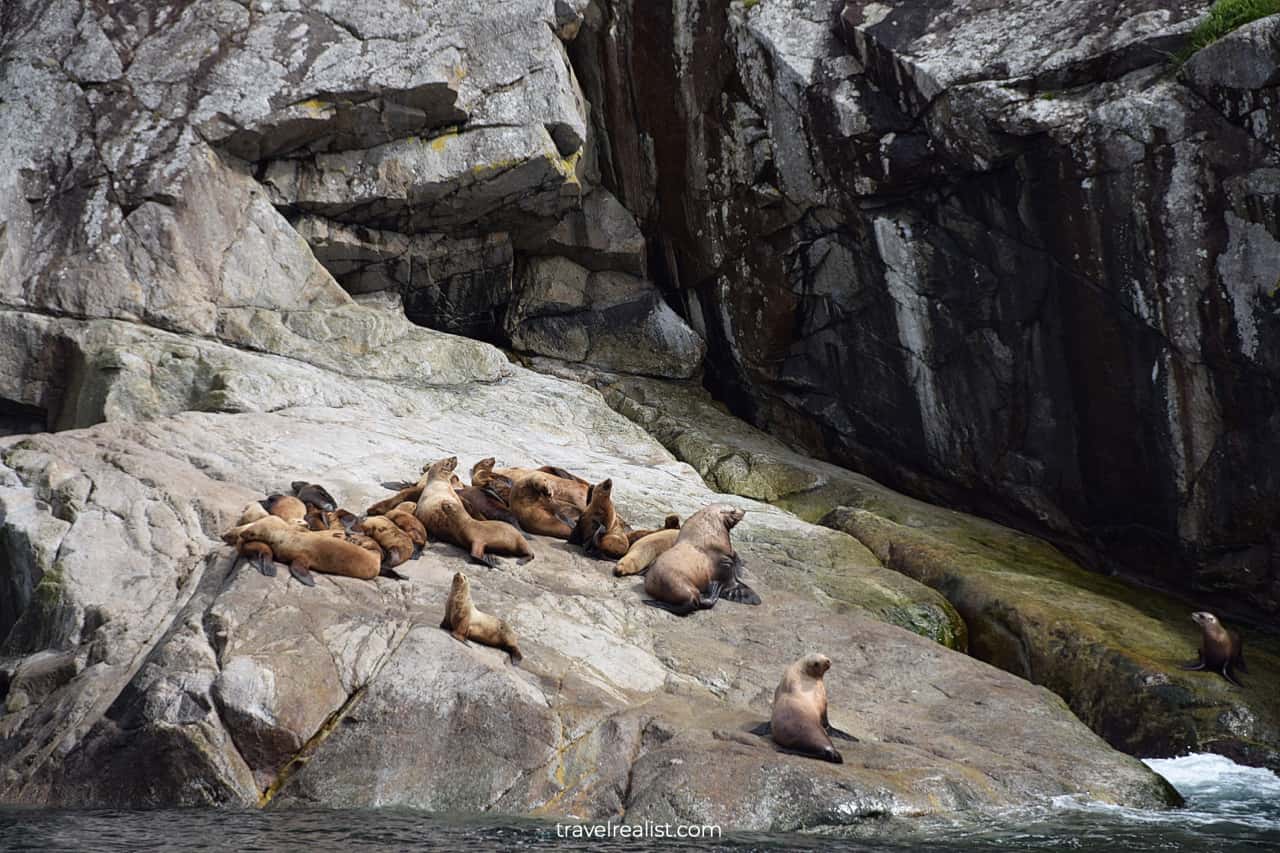
The boat comes fairly close to sea lions. So you can observe their behavior for about 10-15 minutes.
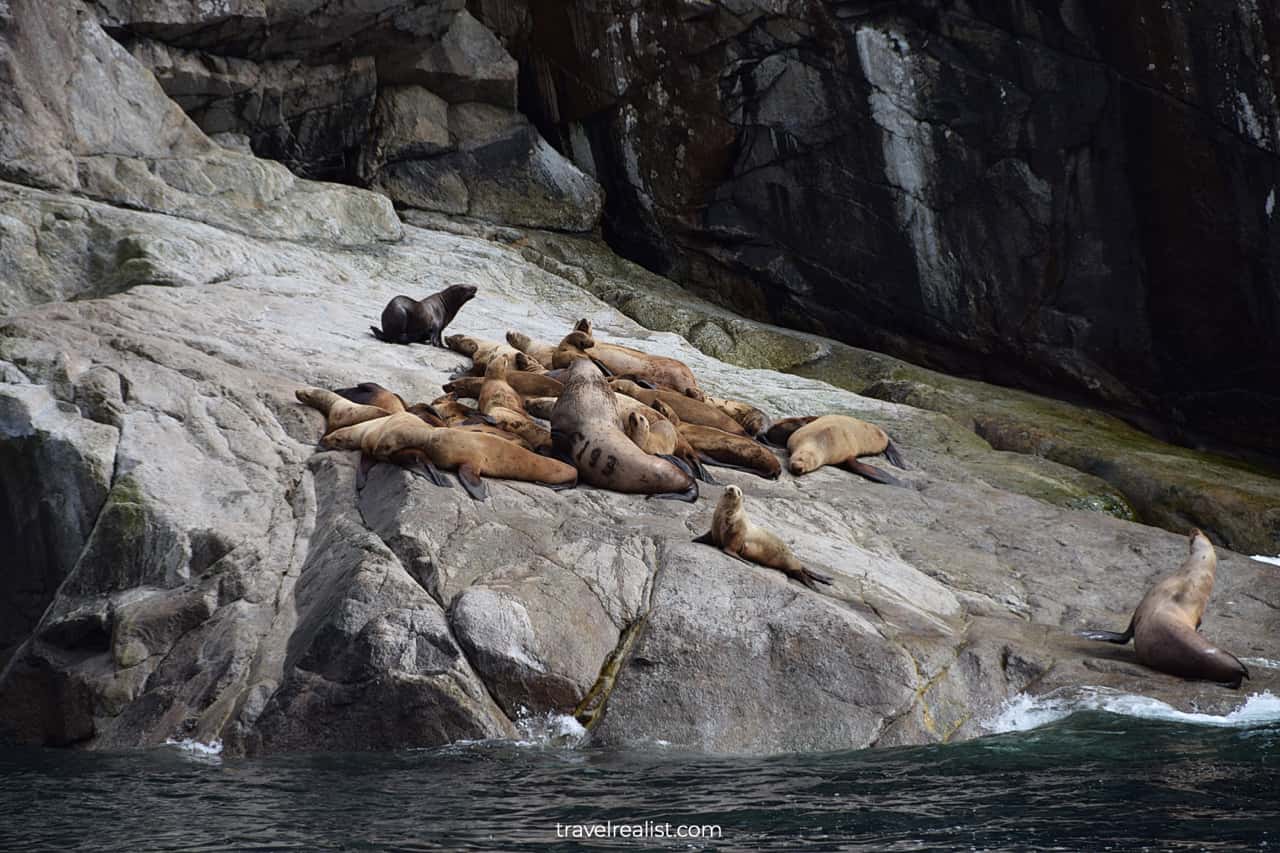
What you will see differs based on the colony and the time of the day. But there are some common behavioral patterns. You might see an alpha male defend the colony from a challenger.
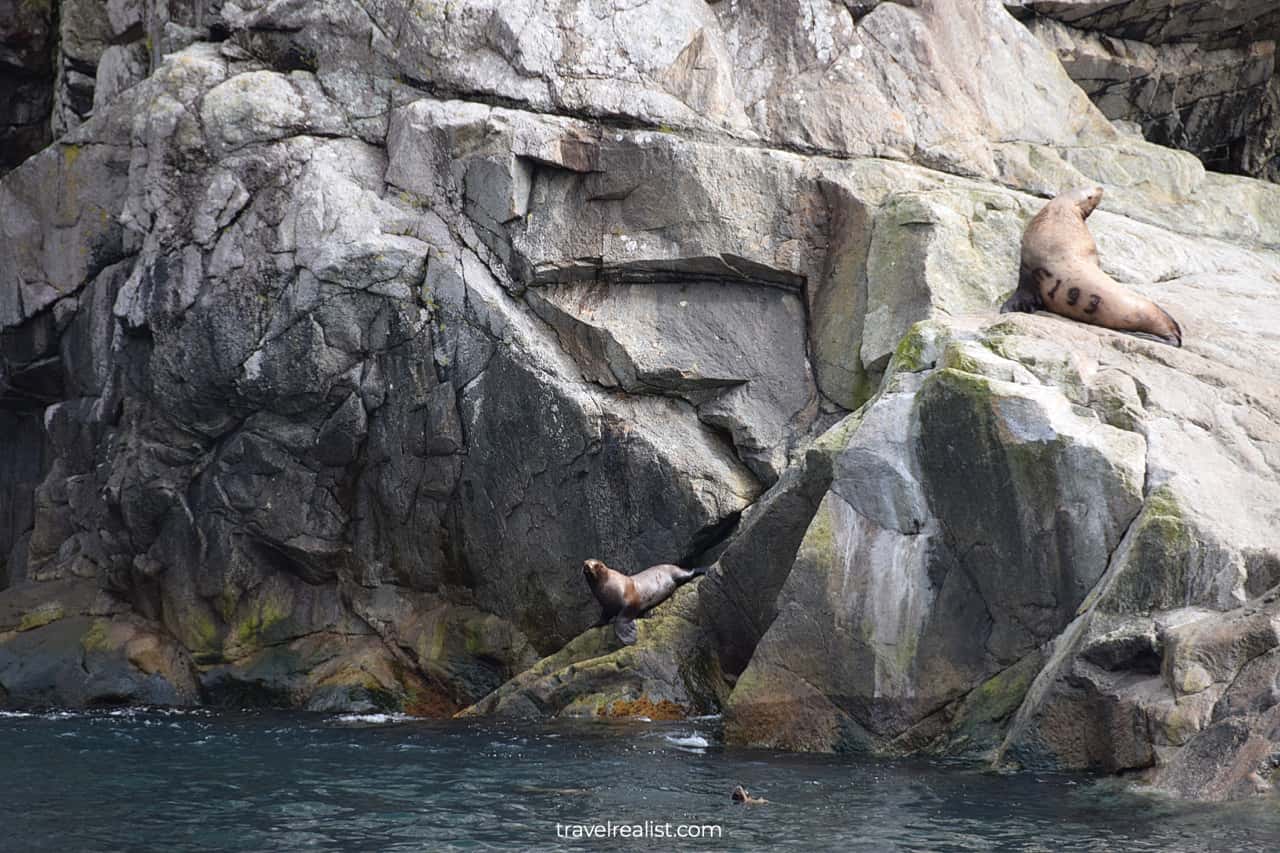
If they succeed in this exchange and return victorious, you will watch a small show in front of the colony.
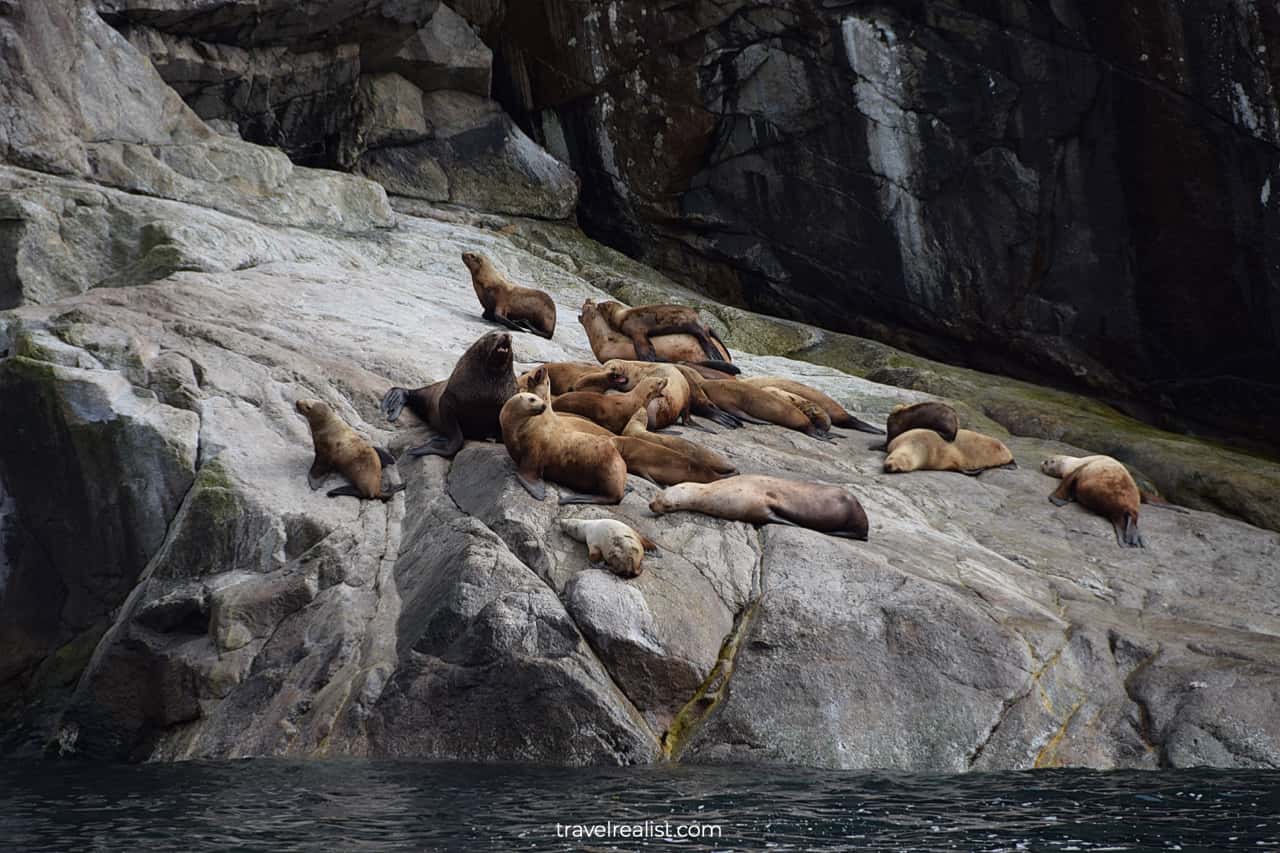
You will clearly hear the sea lion’s roar. Not even the turbulent waters can stop this sound.
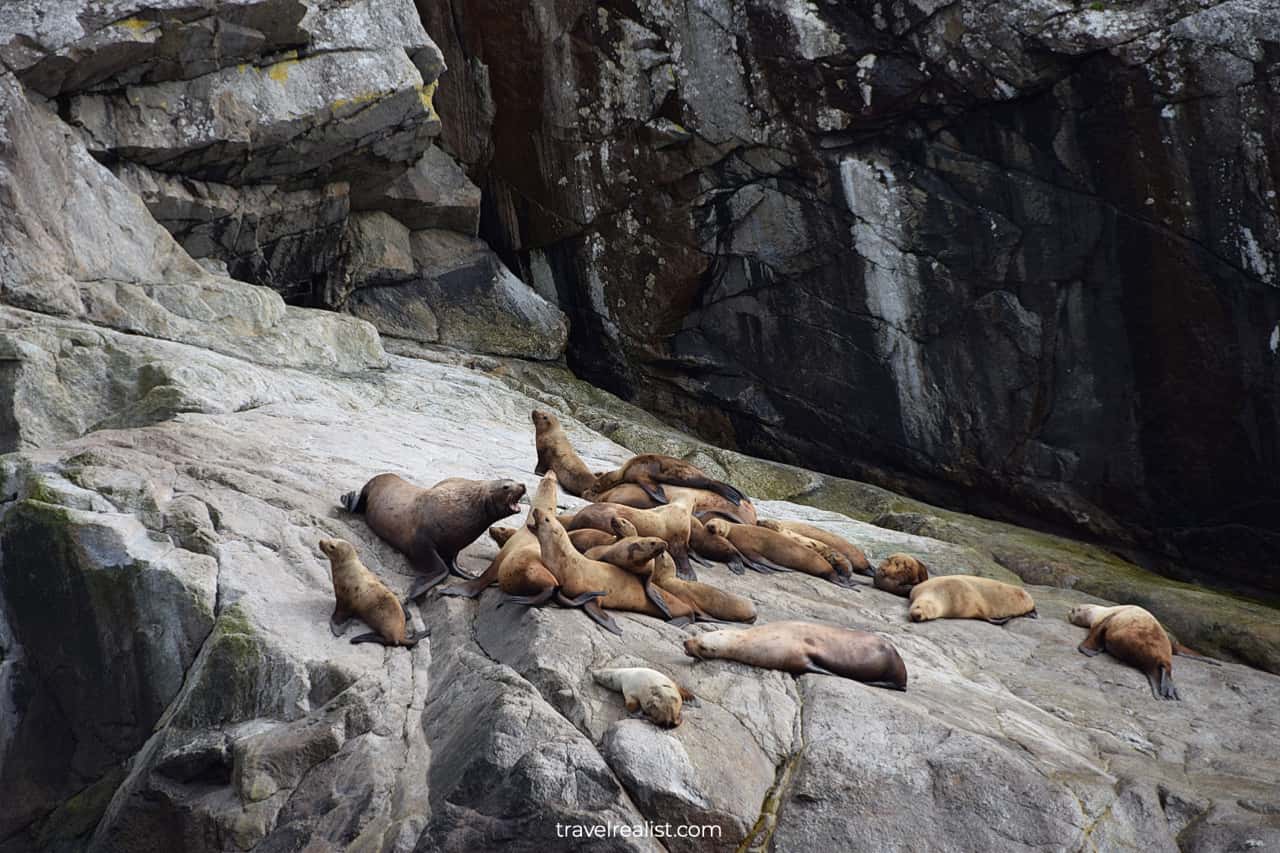
Where to Spot Wildlife in Kenai Fjords
Wildlife spotting in Kenai Fjords is a quite different from Denali and Wrangell-St. Elias. You have even less control over your route than in the other two national parks.
Exit Glacier is the only exception. But for marine wildlife viewing you are at the mercy of your cruise company.
This section of our Kenai Fjords Wildlife Guide will walk you through the main wildlife spots.
Resurrection Bay
On the bright side, most cruises follow a similar route. They start in Seward. And most wildlife viewing takes place in Resurrection Bay.
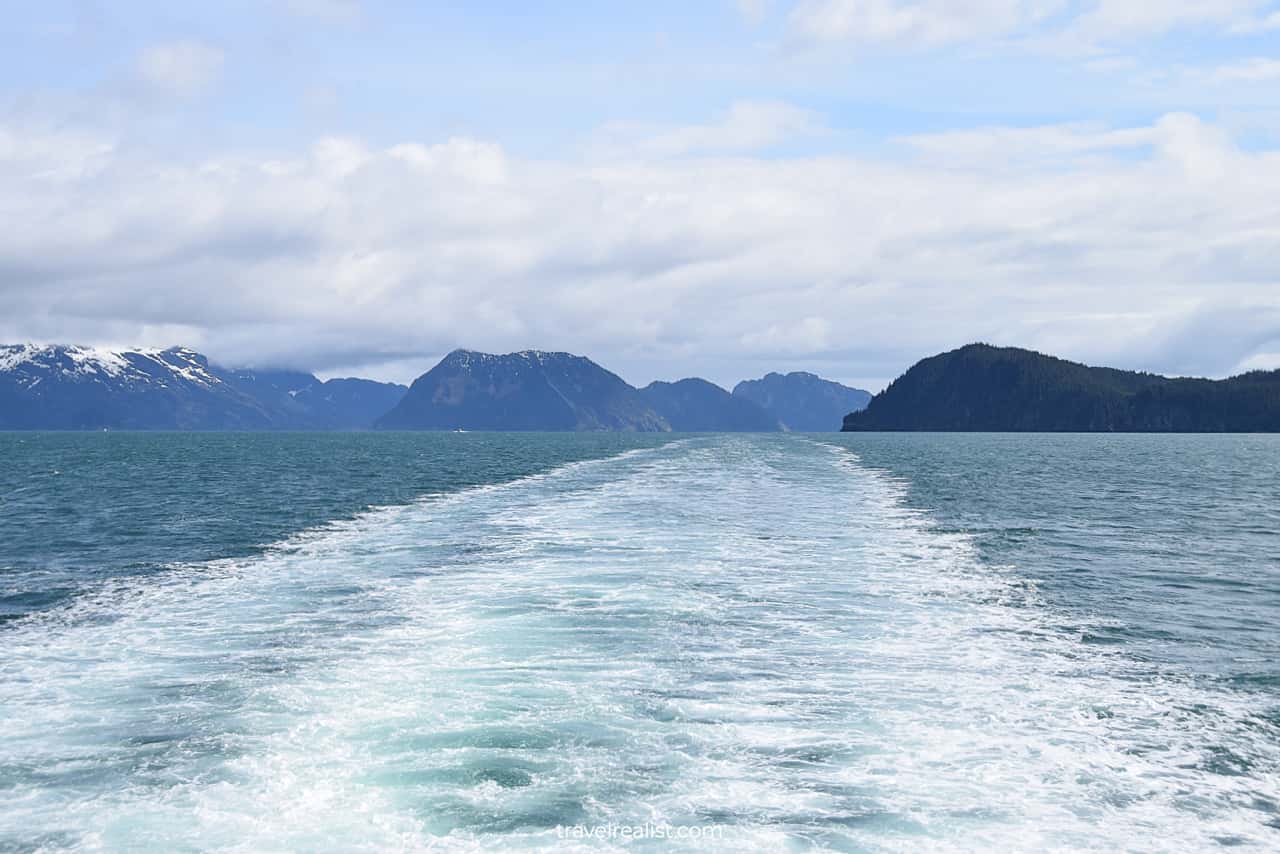
Seward
It does not take long to see animals when the tour begins. In fact, Seward Boat Harbor is a great place to spot sea otters.
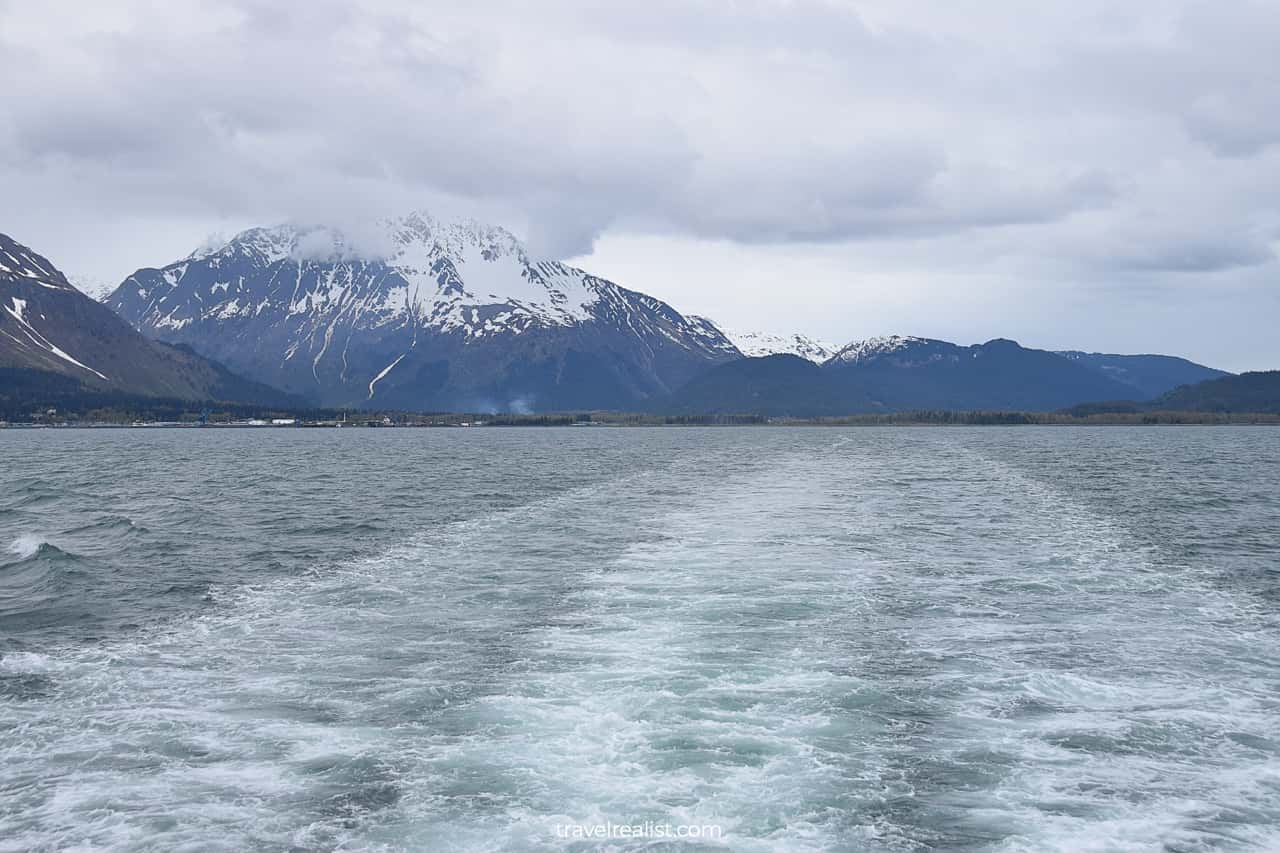
Thumb Cove
An area of the Bay between Seward and Thumb Cove is a known humpback spot. You can easily spend a few hours watching humpbacks. They surface for a minute. And go back for a dive.
Your tour guide will help you guess where a whale can resurface. As soon as the guide makes their announcement, most passengers rush to the named boat side.
Tour guides and captains use a clock system.
- 12 o’clock means the front of the boat.
- 3 o’clock is starboard, the right side.
- 6 o’clock is the back.
- 9 o’clock is port, the left side.
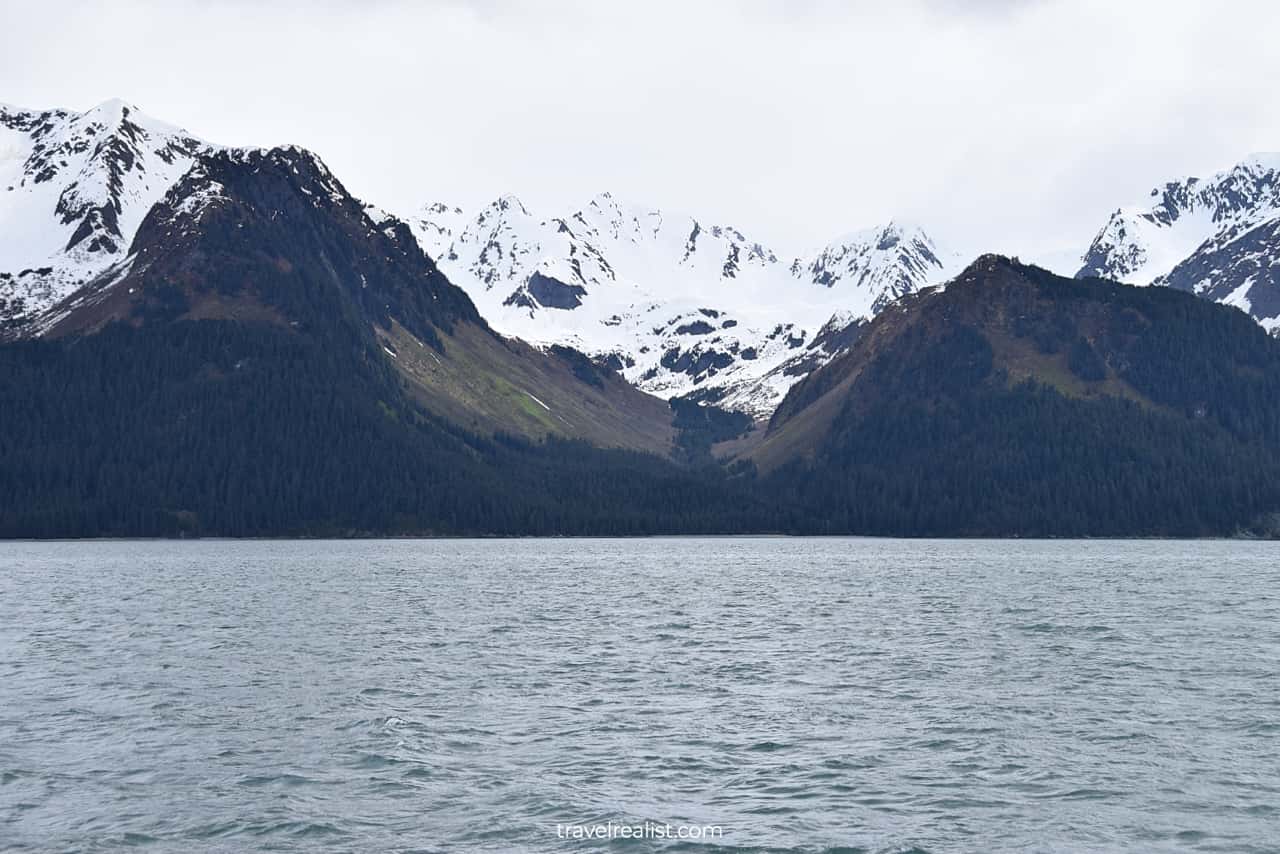
Once you pass Thumb Cove, you will mostly see marine birds for a while. Look for eagles flying high.
Bear Glacier
Bear Glacier is an attraction in itself. The boat does not approach it too closely. But you will get a good distant view.
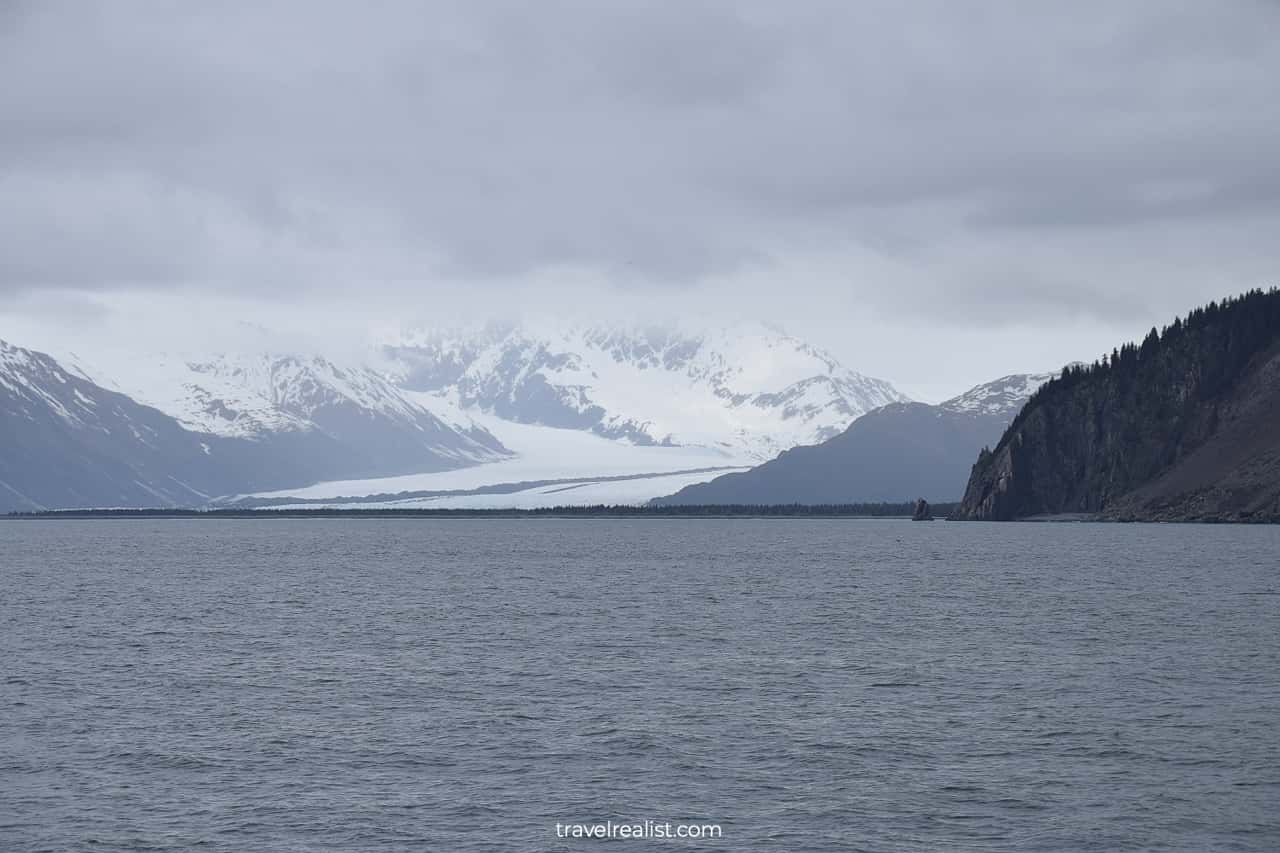
The area between Bear Glacier and Rugged Island attracts orcas. You might not see them on every tour. But your chances are higher between April and November.
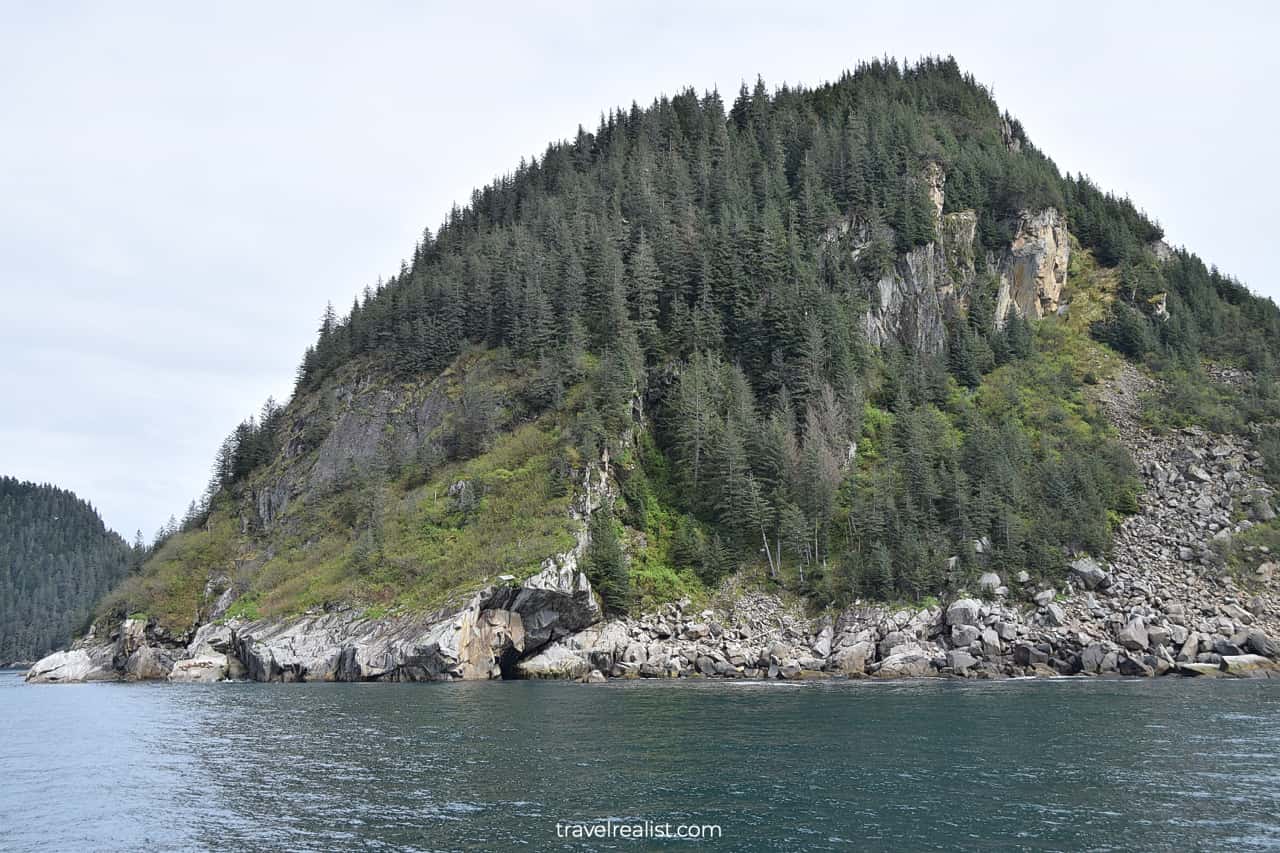
Rugged Island
Rugged Island is home to a sea lion colony. Your boat will make an extended stop near the island. This way, everyone onboard will be able to watch sea lions.
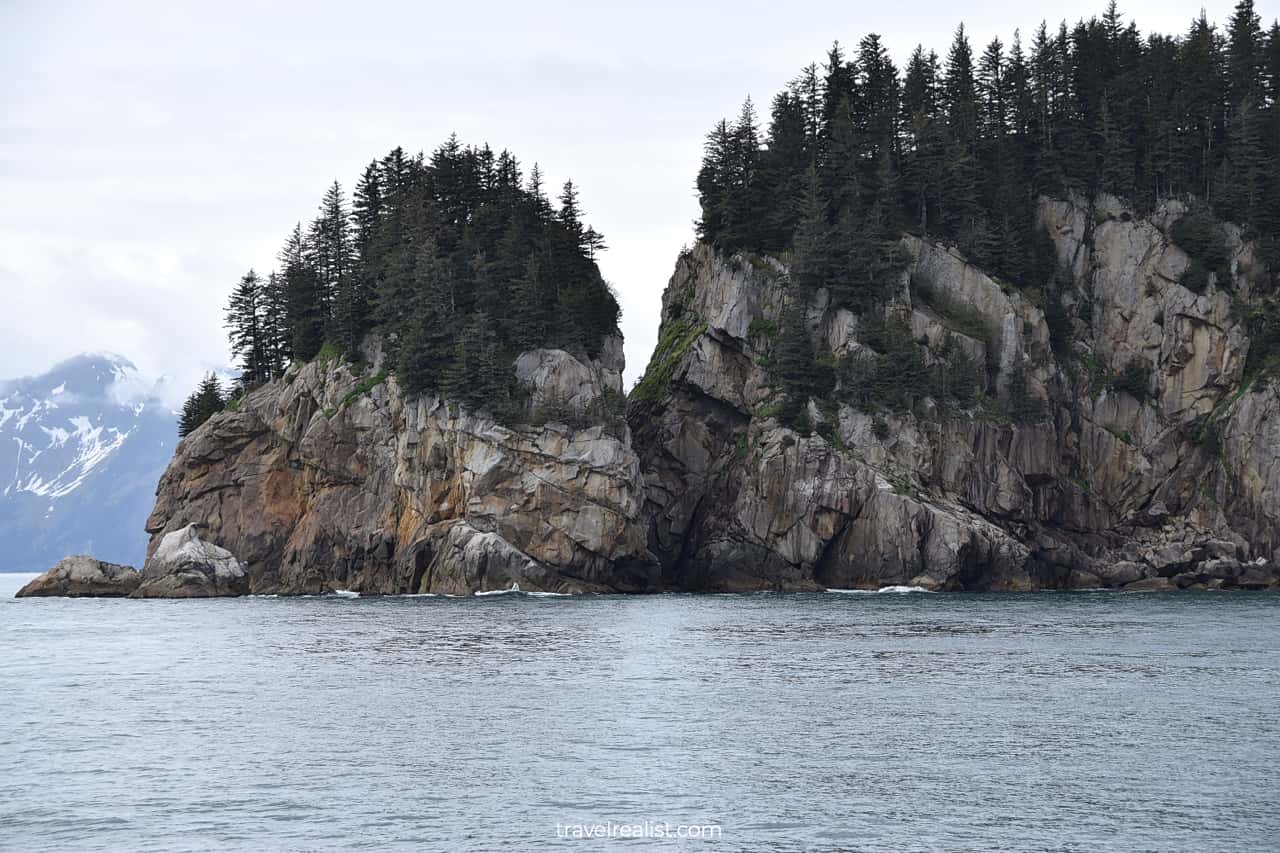
Fox Island
Most tours turn back at Cape Resurrection. Wildlife spotting becomes less of a priority for the rest of the tour. Instead, the boat rushes back to Seward. You have a few chances to see marine birds and sea lions near Fox Island.
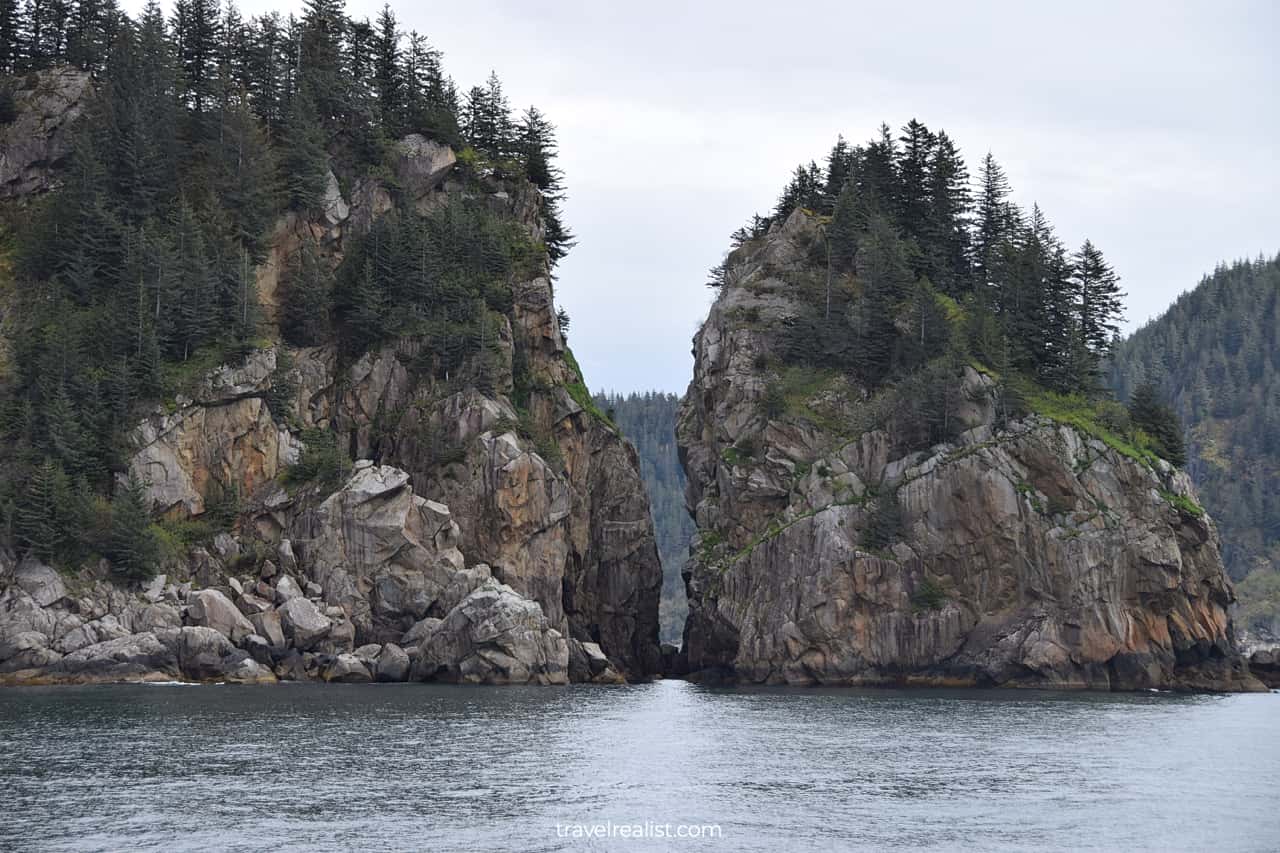
Canes Head
The boat returns to Seward after passing Caines Head. Humpback whales will still be in the area. But the cruise will not stop or approach them. So you would need a good eye or a spyglass to see whales.
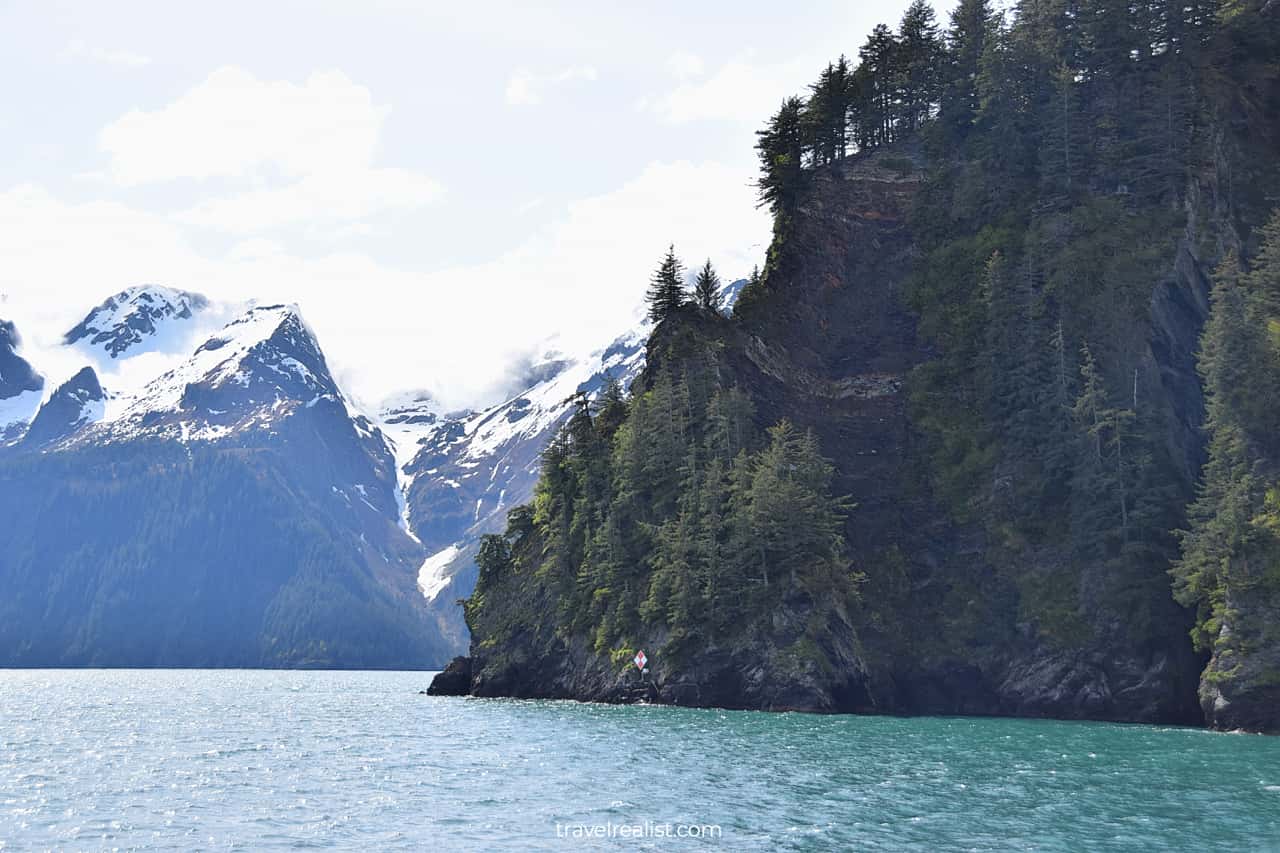
Continue with our Kenai Fjords Wildlife Guide. You will learn more about ways to get to the sights, entrance requirements, and places to stay.
Getting to Kenai Fjords
Kenai Fjords National Park is on Kenai Peninsula, just southwest of Seward. Out-of-state visitors will need to fly to Anchorage. You could then take a rental car or a train to Seward.
It takes about 2.5 hours to drive 125 miles between Anchorage and Seward. But you will likely spend more time. The Seward Highway is one of the most scenic highways in the state. You will pass through Chugach State Park and National Forest. These viewpoints will add time.
There is also a seasonal train to Seward. The Coastal Classic Train runs once a day between mid May and late September. It takes 4.5 hours to reach Seward from Anchorage. The cheapest one-way ticket costs $105+.
Most Kenai Fjords wildlife tours start from Seward Harbor. Exact location depends on your tour company.
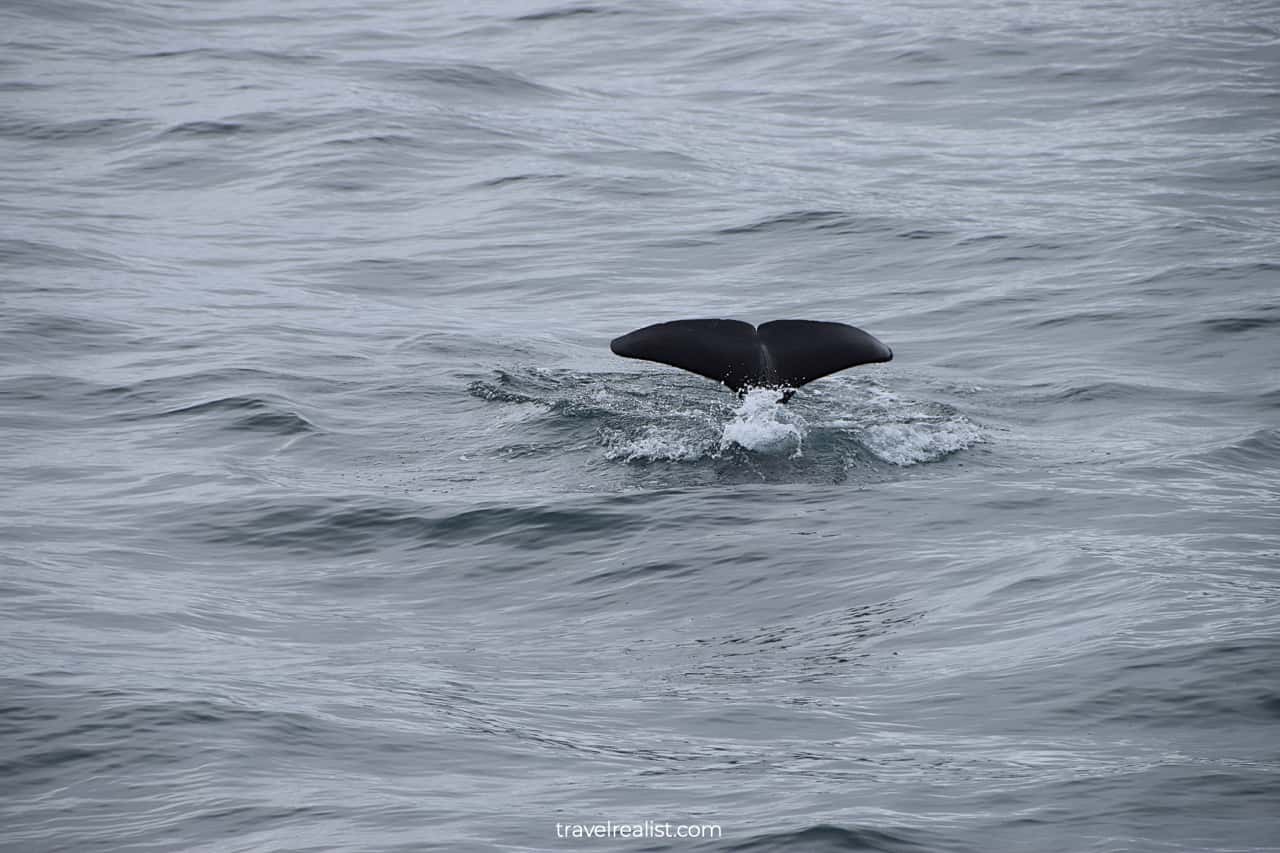
Where to Stay near Kenai Fjords
Seward is the only real destination for places to stay when taking a wildlife tour. Most of the longer tours start early in the day.
So you would have a very early start if you stay in Cooper Landing, Soldotna, or Anchorage. You will have to rush through the scenic drive. And there might be barely any savings.
It is best to get a good night’s sleep in Seward. This way, you could start the day ready for an adventure.
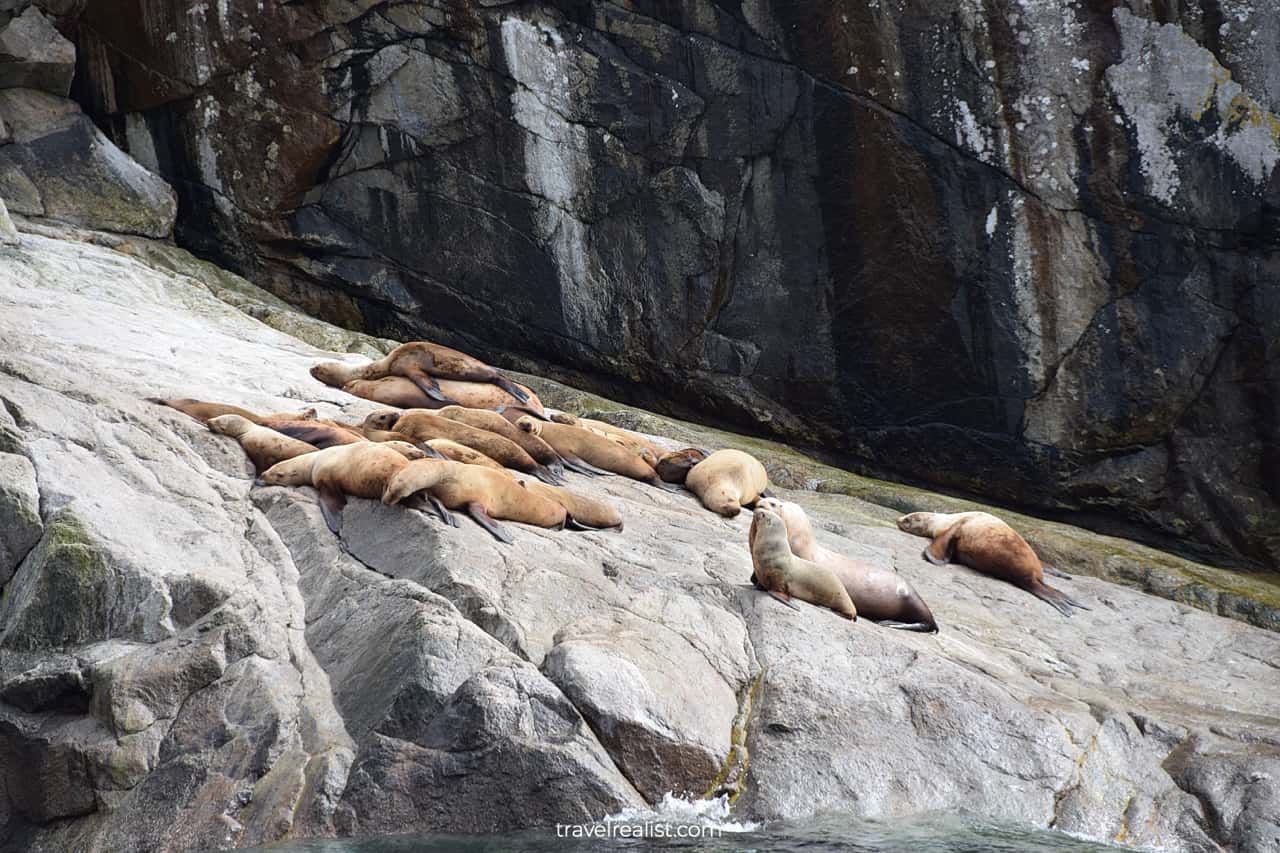
Entrance Requirements & Passes
Kenai Fjords does not charge entrance fees. But the wildlife cruises are not cheap.
There are several companies that offer wildlife cruises in the National Park. The tours differ in starting location, boat size, tour duration and price. Here are the most common options.
- 4-hour cruise: you will pay $125+ per adult. Some companies offer discounts if you book online.
- 6-hour cruise: starts at $189 per adult. Most tour operators charge $199.
- 8 or 8.5-hour cruise: costs at least $215 per adult. Exact pricing depends on the route.
Tours start from Seward Harbor. If you drive to the harbor, get ready for a slight disappointment. A daily parking fee is not part of the tour price. You would have to pay $10 per vehicle out of pocket.
It is a small fee. But the tour operators in Ventura, CA and Akureyri, Iceland cover it for whale watching tours.
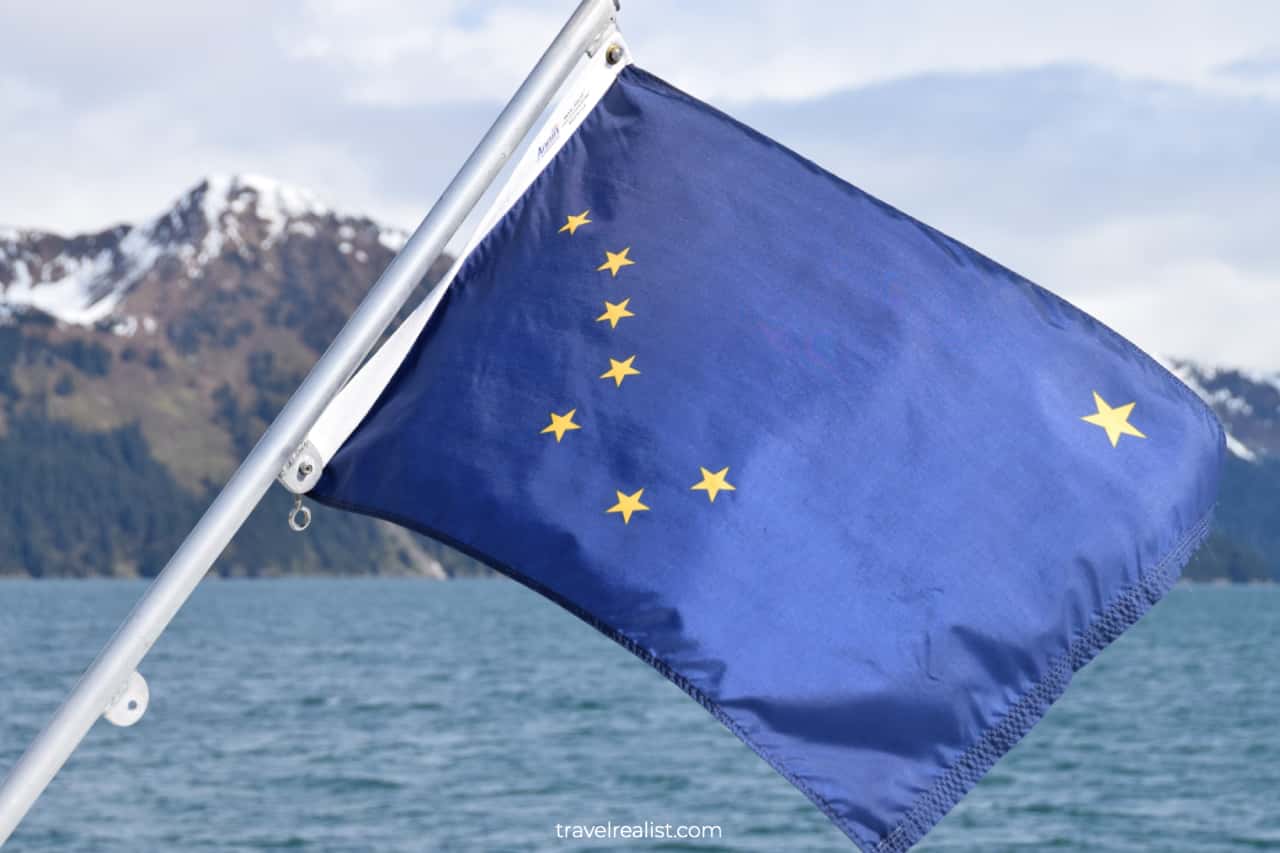
Takeaways: Kenai Fjords Wildlife
Kenai Fjords is a beautiful national park. It is a great way to spot numerous marine animals. You can hope to see humpback, finke, and orca whales. Sea otters, sea lions, and harbor seals are regulars in the Bay.
Follow a few tips to make the most from your trip to Kenai Fjords.
- Book your wildlife cruise as soon as the navigation times are set.
- Book a cheaper cruise early or late in the season. You can save if you do not mind last minute cancelations.
- Compare multiple tour operators to find a combination of price, duration, and starting time that works for you.
- Arrive in the harbor early to pay for parking.
- Keep an eye on marine birds to better predict where a whale will resurface.
- Wear layers and waterproof clothes to stay warm.
- Spend time in the rear of the boat to decrease chances of motion sickness.
Take a look at our Kenai Fjords Wildlife Video Guide. And visit our YouTube channel for the latest videos.
Frequently Asked Questions
Kenai Fjords is one of the best destinations for wildlife spotting. You could see bears and moose near Exit Glacier. And you could spot whales, sea otters, sea lions, and marine birds on a cruise. The park is well worth a visit.
Kenai Fjords National Park is a scenic destination. It has a rugged coastline. The park is home to the Harding Icefield. It is one of the largest ice fields in the world. The park is also an amazing place for wildlife viewing.
Summer is the best time to visit Kenai Fjords National Park. Most cruise companies start navigation around mid May. The tours continue daily through the summer until late September.
Kenai Fjords is a great location for whale watching. You can see humpback and orca whales on most tours. It is rare but possible to see finke and gray whales.
You need at least one full day in the park. A wildlife cruise takes at least 4 hours. You can explore the Exit Glacier after the tour.
You can see orcas in Kenai Fjords during summer. Late May to mid June is the best time for orca viewing.
Kenai Fjords National Park is free to visit. But you can only get to the Exit Glacier area of the park. Wildlife cruises in the park cost at least $125 per adult.
Do your research, dress for the weather, and get ready for motion sickness.
Safe realist travels!

